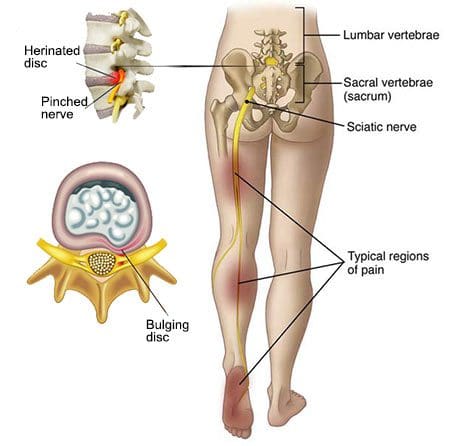
Neck Braces, Cervical Collars: Types of Spinal Bracing
An individual may need to wear a neck brace or cervical collar after cervical spine surgery, or after experiencing a traumatic injury to the neck, from an automobile accident, sports, work, or personal injury. Neck braces are some of the most common spinal braces. A doctor might call these orthoses or orthotics. There are different types of neck braces also called cervical collars, and function for different purposes.
- They can be utilized in stabilizing the neck after cervical/neck surgery.
- They can provide non-surgical relief after experiencing trauma or injury to the neck
Neck braces or collars are used to limit movement, support the head, and take the load off the neck. This gives the muscles time to rest, recover, and heal properly and thoroughly. �
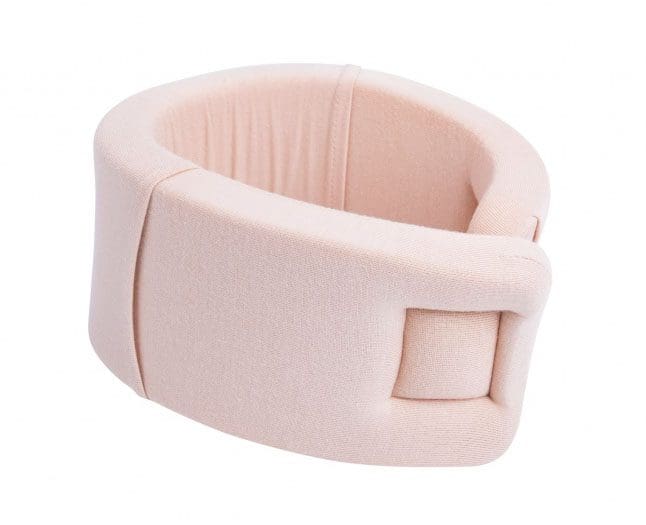
- Soft and Hard Collars
- Philadelphia Collar
- Sterno-occipital-mandibular Immobilization Device
- Halo brace
Contents
�
Soft and Hard Neck Braces
Soft braces are made to be flexible and are made of a polyurethane foam rubber. They easily wrap around the neck and are secured with Velcro.
Soft collars are usually worn for a minor injury that just needs to be worn for a short time or to transition from wearing a hard brace from a more serious injury or surgery. Soft braces are worn typically at the end or completion of the healing process. The main purpose is to help with the gradual transition to remove the brace.
Hard neck braces look sort of like soft braces. The difference is that they are made of hard polyethylene and are rigid/stiff to really keep the neck from moving. These braces provide support and pain relief for spinal conditions like cervical spondylosis and acute neck pain. �
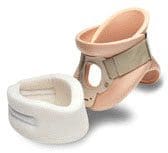
�
Philadelphia
A Philadelphia brace is made of stiff foam and is made in two pieces that attach with Velcro. The upper portion supports the lower jaw with the lower brace extending down to cover the upper back.
This brace is made to protect more of the neck area than a soft or hard brace. However, it does place a higher restriction on the neck and body’s range of motion. Because of its effectiveness for limiting movement, it is usually prescribed after cervical surgery for a healthy recovery. The Philadelphia neck brace is also used for stabilization of minor cervical fractures and to reduce pain brought on from neck muscle strain. �
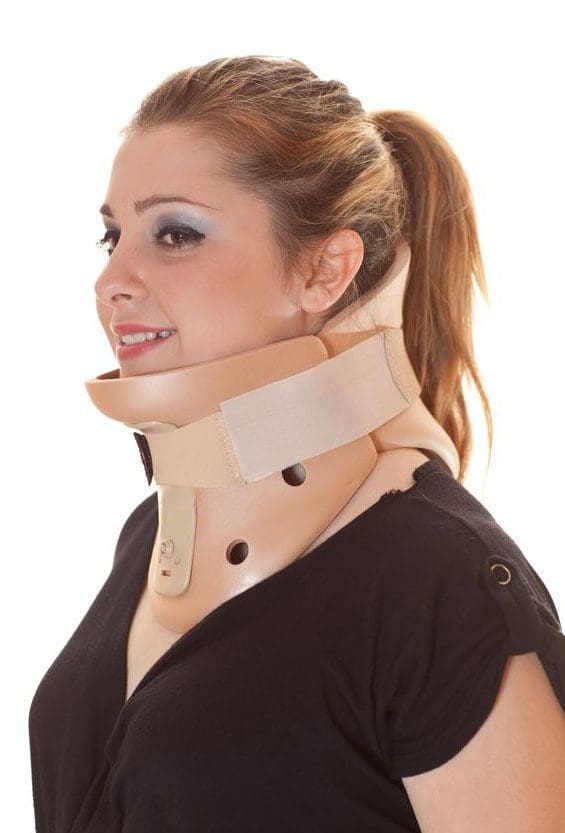
Sterno-Occipital-Mandibular Immobilization
The Sternooccipital mandibular immobilization brace is a highly rigid brace used to position the neck in straight alignment with the spine. This brace immobilizes the neck completely by preventing the head and neck from moving at all. This allows the injured/damaged structures to heal correctly and quickly. Sterno comes from the sternum. The brace has a front chest plate, and bars that go over the shoulder. �
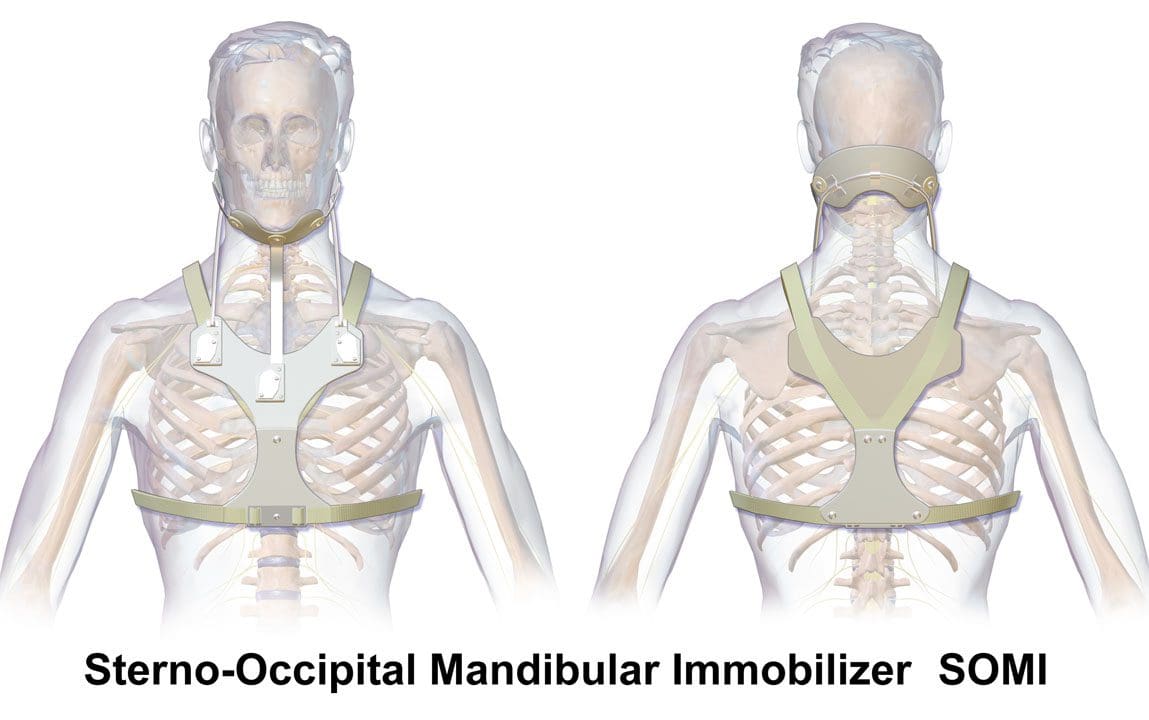
It is secured with straps that attach to the front chest plate. It also has a removable chin piece where the mandibular comes from, which is the lower jawbone. And there is an optional headpiece for added protection and support. Occipital is referring to the occipital bone at the back of the head. This type of brace is used for the treatment of severe neck injury/s or cervical pain caused by a chronic condition, like arthritis. It can also aid in recovery after cervical spine surgery.
�
Halo
The halo brace is the most rigid of the neck braces. It completely immobilizes the head and neck from moving. Sometimes it is necessary to immobilize the spine after a major neck procedure or for stabilizing fractures in the neck or middle back area. Halo bracing is considered a form of spinal traction. Traction pulls the spine in 2 different directions.
The tension reduces the abnormal curvature associated with spinal conditions, like scoliosis. A halo brace has a metal ring secured to the head using pins. The ring is connected to bars that are attached to a properly weighted vest. The weight of a halo brace is different depending on the individual wearing it. A halo brace is worn at all times until completely healed and recovered. �
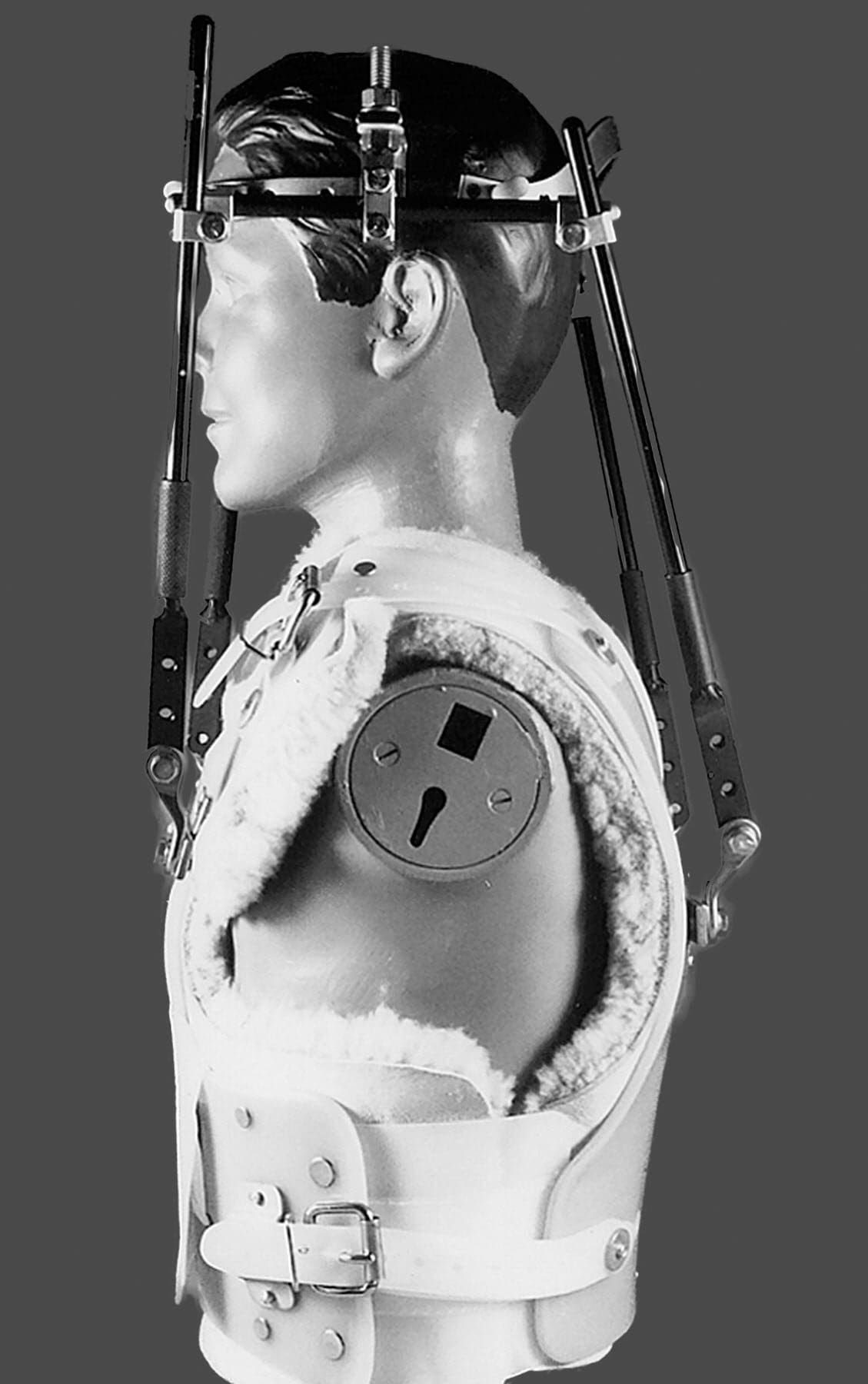
Effectiveness
Neck braces are the most effective when they are used as directed by a doctor, chiropractor, or spine specialist. Working with an orthotist, or a specialist that designs and custom fits spinal braces can be extremely beneficial. Any questions about how to wear and care for a spinal brace should be brought up with a doctor or orthotist. They will help ensure a full understanding of how to get the most benefit from the treatment.
�
Neck Pain Chiropractic Treatment
Dr. Alex Jimenez�s Blog Post Disclaimer
The scope of our information is limited to chiropractic, musculoskeletal, physical medicines, wellness, and sensitive health issues and/or functional medicine articles, topics, and discussions. We use functional health & wellness protocols to treat and support care for injuries or disorders of the musculoskeletal system. Our posts, topics, subjects, and insights cover clinical matters, issues, and topics that relate and support directly or indirectly our clinical scope of practice.*
Our office has made a reasonable attempt to provide supportive citations and has identified the relevant research study or studies supporting our posts. We also make copies of supporting research studies available to the board and or the public upon request. We understand that we cover matters that require an additional explanation as to how it may assist in a particular care plan or treatment protocol; therefore, to further discuss the subject matter above, please feel free to ask Dr. Alex Jimenez or contact us at 915-850-0900. The provider(s) Licensed in Texas& New Mexico*

Spinal Meningitis Can Affect the Spine: What to Know
Spinal meningitis does not just affect the brain. Most think of meningitis as a brain disease, but it can also affect the spine. We will discuss learning how to recognize it and find the right treatment to fix it within the spinal cord. Spinal meningitis can be a potentially deadly infection of the meninges. This is the protective tissue that covers the brain and spinal cord.
It can be caused by viruses, bacteria, or fungi that are transmitted from person to person by sneezing, talking, and sharing food. Viruses and pathogens that cause other infections, like the mumps and measles, can also cause meningitis. The lining around the brain and the spine are connected, which means that infection can travel from one area to another, or remain in the brain or the spine.
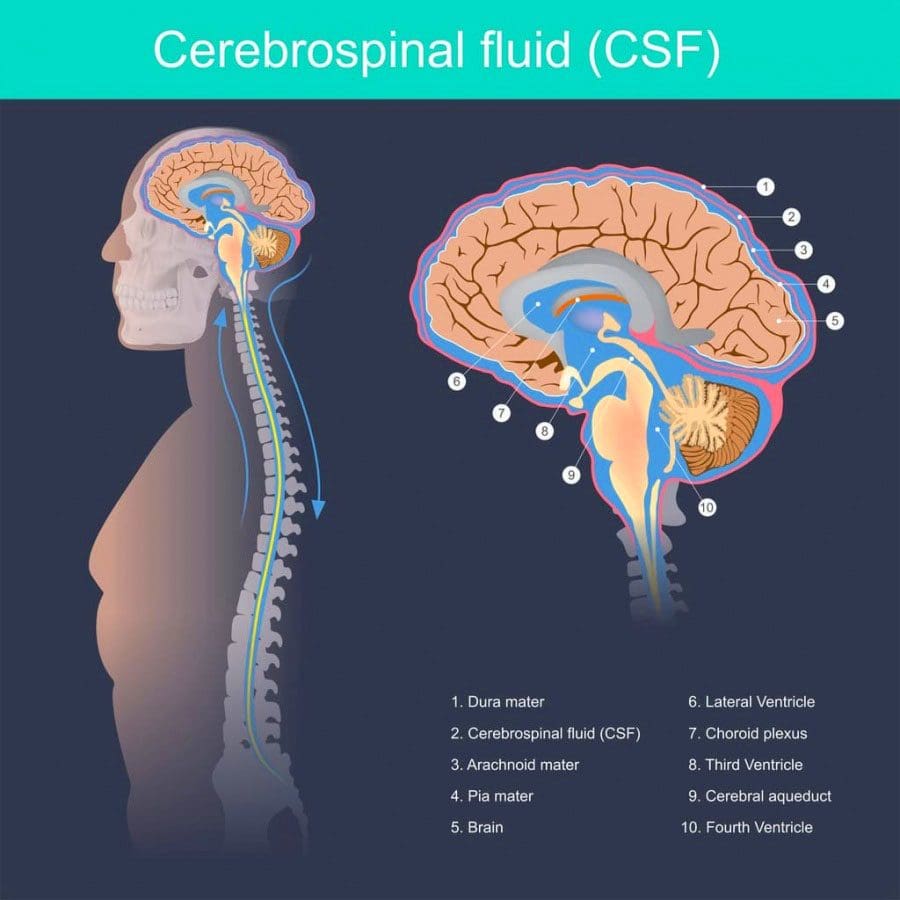
Contents
�
The Meninges
Meninges are the protective membranes that surround the brain and spinal cord. They are made up of three layers:
- Dura mater is the thick and tough outer layer
- Arachnoid mater is the middle layer made up of strands of connective tissue
- Pia mater is the inner layer of cells
Spinal meningitis can develop when a virus, bacteria, or pathogen invade the meninges layers. This causes the immune system to react trying to remove the invading bacteria etc, which causes inflammation. These organisms usually take up residence in the nose and throat and never cause problems. Most individuals that come into contact with these viruses never get sick.
The reason for this is because the body produces fighting antibodies before the pathogens can invade the meninges. Others, possibly from age or underlying conditions, where they are not able to produce enough or any antibodies, makes them vulnerable to the illness. When the brain and spine’s tissue/s get infected with any one of these pathogens, the tissue swells, which constricts proper blood flow to the brain.
Types of Spinal Meningitis
The most common types of spinal meningitis in the United States include:
Viral meningitis
Viral meningitis is caused by enteroviruses, which are common viruses that enter the body through the mouth and travel to the brain and tissues where multiplication ensues. There are other viruses that can also cause meningitis. These include:
- Viruses that cause mumps
- Herpesviruses – like Epstein-Barr, measles, influenza, West Nile
- Lymphocytic choriomeningitis virus from rodents
Any of these viruses can spread to the meninges, causing spinal meningitis to develop. This is a less severe type than bacterial meningitis.
Bacterial meningitis
This is the type where dangerous bacteria invade the meninges. Individuals are at higher risk as this type can be fatal if not treated. Common types of bacterial meningitis include:
- Haemophilus influenzae – can cause severe infection/s of the lining of the brain, spinal cord, and the blood.
- Pneumococcal meningitis – is caused by the bacterium Streptococcus pneumonia and is the most common form of bacterial meningitis.
- Meningococcal meningitis – also known as meningococcal disease, is a less common type. This type is caused by the bacterium Neisseria meningitides. Around 2,600 people in the U.S. are affected yearly.

Symptoms
Viral or bacterial spinal meningitis can cause a range of symptoms, including:
- Neck and back stiffness
- Muscle weakness
- Headache
- Drowsiness
- Fatigue
- Fever
- Double vision
- Sensitivity to light
- Nausea
- Vomiting
- Hearing difficulty
- Confusion
- Seizures
- Rash
Symptoms are often far more pronounced with the bacterial form. This is because it�s associated with more inflammation, compared to the viral type.
Complications
Depending on the type whether viral or bacterial the results can be serious, leading to:
- Permanent brain damage
- Permanent organ damage
- Stroke
- Loss of hearing
- Loss of limbs
- Death
Anyone who experiences symptoms of meningitis should see a doctor immediately for diagnosis and treatment options.
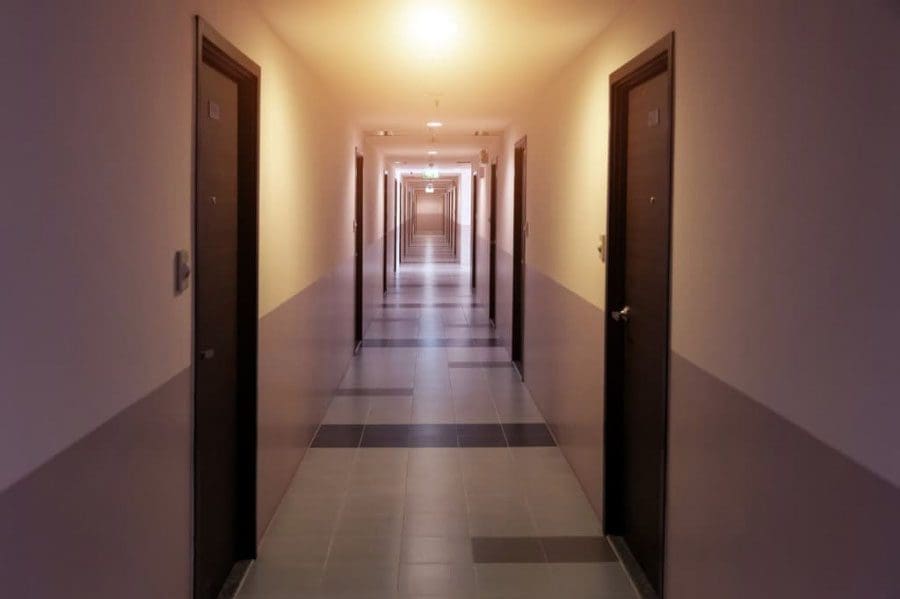
Risk for Spinal Meningitis
Getting spinal meningitis depends on various factors like:
- Age
- Immune system status
- If the individual lives in a group environment
- Children younger than five
- Individuals with weakened immune systems from taking medication/s for other conditions
- Recent organ/bone marrow transplants
- Babies younger than 1-month-old along with weakened immune systems are more likely to experience severe illness
These are factors that could increase the risk of viral meningitis. Fortunately, most cases are not serious and in children’s cases, most recover in one to two weeks. Meningitis can also occur very rarely after spine surgery where the lining around the dura is torn with an infection happening at the same time.
Diagnosis
Detecting spinal meningitis a doctor will utilize:
- Blood tests
- Imaging tests
- Spinal tap to test the cerebrospinal fluid which surrounds the brain and spinal cord.
- The fluid is collected and sent to a lab, where it is analyzed for bacteria or viruses.

Treatment
Antiviral medication can help with certain types of viral meningitis with other meds for treating meningitis symptoms. Doctors recommend bed rest, proper fluids, and medication for fever relief and headache relief. This is for viral meningitis.
Antibiotic medications can treat bacterial spinal meningitis. It is commonly treated with intravenous antibiotics in a hospital setting. Unfortunately, around ten percent of children with bacterial meningitis die from it yearly. Even with immediate antibiotic treatment a child’s body can become overwhelmed by the bacteria/organism. The Meningococcus bacteria can create a toxin that invades the blood. This can be fatal for a child or adolescent within hours. This is why it�s highly recommended to prevent bacterial meningitis than to treat it once it’s active.
Contagious
Proper hygiene like hand washing, not sharing food, beverages, utensils, or body care products like lip salve/balm can help stop the spread of bacterial and viral meningitis.
Neck Pain Chiropractic Care
Dr. Alex Jimenez�s Blog Post Disclaimer
The scope of our information is limited to chiropractic, musculoskeletal, physical medicines, wellness, and sensitive health issues and/or functional medicine articles, topics, and discussions. We use functional health & wellness protocols to treat and support care for injuries or disorders of the musculoskeletal system. Our posts, topics, subjects, and insights cover clinical matters, issues, and topics that relate and support directly or indirectly our clinical scope of practice.*
Our office has made a reasonable attempt to provide supportive citations and has identified the relevant research study or studies supporting our posts. We also make copies of supporting research studies available to the board and or the public upon request. We understand that we cover matters that require an additional explanation as to how it may assist in a particular care plan or treatment protocol; therefore, to further discuss the subject matter above, please feel free to ask Dr. Alex Jimenez or contact us at 915-850-0900. The provider(s) Licensed in Texas& New Mexico*
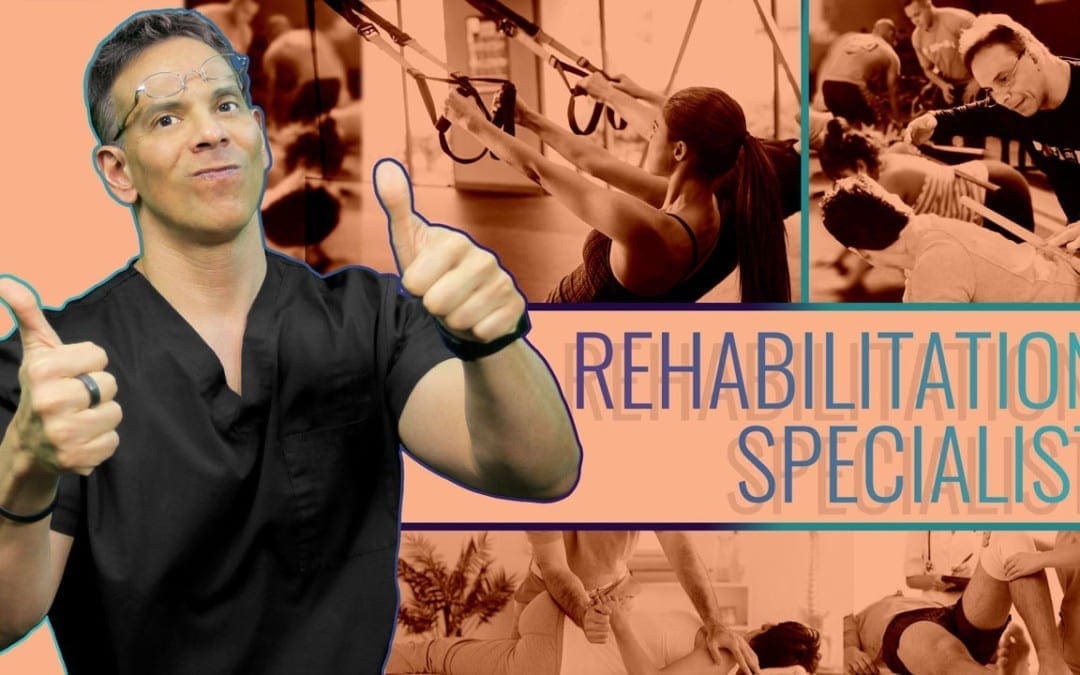
Chiropractic Doctors / Chiropractic Physicians* and What They Do
Alexander Jimenez grew up knowing he was going to be a chiropractic doctor. As a child, Dr. Jimenez’s grandmother (Rebecca Tinoco of Bogota, Columbia)� experienced pain symptoms and would ask little Alex to massage the painful areas. His grandmother found relief and Dr. Jimenez began to think about how he could help others experiencing pain. �
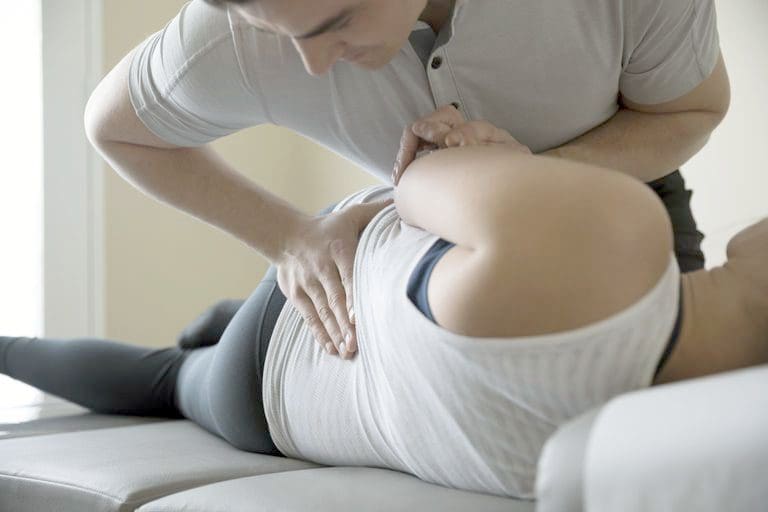
It was through this care that Dr. Jimenz realized being a health care chiropractic practitioner was the best way to help people. Like his grandfather, many others have experienced profound results thanks to chiropractic treatment. Dr. Jimenez knew that he wanted to be able to treat patients naturally. He would learn and develop the skills required to practice as a chiropractic physician. He enrolled in a university chiropractic program, graduated, has put in almost 30 years of work, and the rest is history. What to know about chiropractic physicians.
Contents
�
A Chiropractic Physician*
A Doctor of Chiropractic also known as a D.C. is far more than a back doctor. Chiropractors study the same sciences as doctors of medicine or MDs. They are trained in the latest techniques and approaches, diagnostic tools, and developing effective treatment plans to manage various health conditions. However, chiropractic physicians specialize in non-invasive/non-surgical/non-pharmacological health care protocols and focus on whole-body health and natural healing. Wide range of factors that can impact an individual�s health like:
- Biomechanical dysfunction
- Diet
- Genetics
- Trauma
- Hygiene
- Emotions
- Environment – Home/work
- Infection/s
- Lack of exercise
- Posture
- Stress levels
Based on these factors a chiropractor is able to determine the most effective, beneficial natural treatment plan.
�
Work
Chiropractic physicians encourage individuals to look at natural, medication/surgery-free approaches to improve health, reduce, and alleviate painful symptoms. They are often called upon for preventive and rehabilitative health care. �
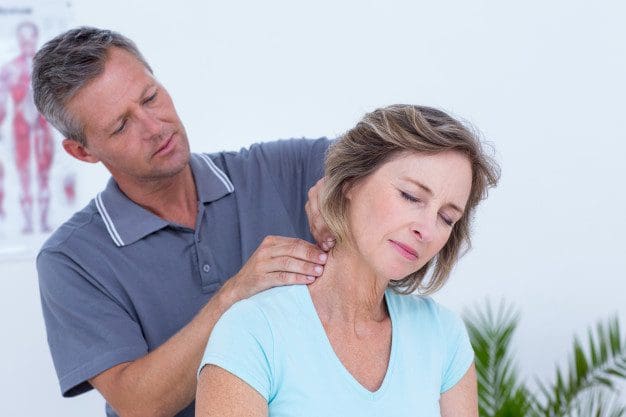
� Chiropractic treatment is responsible for thousands of back surgeries being avoided, as well as injuries being prevented with conservative care. Chiropractors perform manual, and tool-assisted adjustments of the spine and the body’s other joints. Depending on their training, they could practice:
- Acupuncture
- Functional medicine
- Nutritional medicine
- Physical rehabilitation
- Provide supplements like vitamins and natural botanicals
Chiropractors utilize diagnostic tests like X-rays, ultrasound, and check blood pressure. They can order and interpret blood samples, urine samples, and other medical lab tests. Chiropractic physicians are able to:
- Practice as primary-care physicians in most states
- Can become licensed in all states
- Own general or specialized practice
- Work as an associate in a group practice
- Specialize in fields like:
- Sports medicine
- Acupuncture
- Pediatrics
- Women�s health
- Neurology
- Hospital work
- Wellness institutions
- Veteran care
- Multi-disciplinary and integrative clinics
- Conduct research
- Teach at chiropractic medical colleges

Treatment
Doctors of chiropractic are able to treat individuals of all ages, and a variety of health conditions. Most know about chiropractors and their expertise in treating back pain, neck pain, and headaches. However, chiropractors can also treat many types of injuries and disorders involving the musculoskeletal system. They can:
- Release tight muscles
- Stretch out ligaments
- Return joint mobility
- Relieve overuse/repetitive injuries
- Ease migraines
- Rehabilitate/Prevent sports injuries
- Treat automobile accident injuries
- Reduce/Alleviate arthritis
The Most Effective Chiropractor
�
Dr. Alex Jimenez�s Blog Post Disclaimer
The scope of our information is limited to chiropractic, musculoskeletal, physical medicines, wellness, and sensitive health issues and/or functional medicine articles, topics, and discussions. We use functional health & wellness protocols to treat and support care for injuries or disorders of the musculoskeletal system. Our posts, topics, subjects, and insights cover clinical matters, issues, and topics that relate and support directly or indirectly our clinical scope of practice.*
Our office has made a reasonable attempt to provide supportive citations and has identified the relevant research study or studies supporting our posts. We also make copies of supporting research studies available to the board and or the public upon request. We understand that we cover matters that require an additional explanation as to how it may assist in a particular care plan or treatment protocol; therefore, to further discuss the subject matter above, please feel free to ask Dr. Alex Jimenez or contact us at 915-850-0900. The provider(s) Licensed in Texas& New Mexico*
NOTICE: The Texas Board of Chiropractic and The Texas Supreme Court defines a Chiropractor as a Doctor. New Mexico State Bylaws and New Mexico Chiropractic State Board define a Chiropractor as a Chiropractic Physician*.
Both are the same however the bylaws require legal and literal defining.�
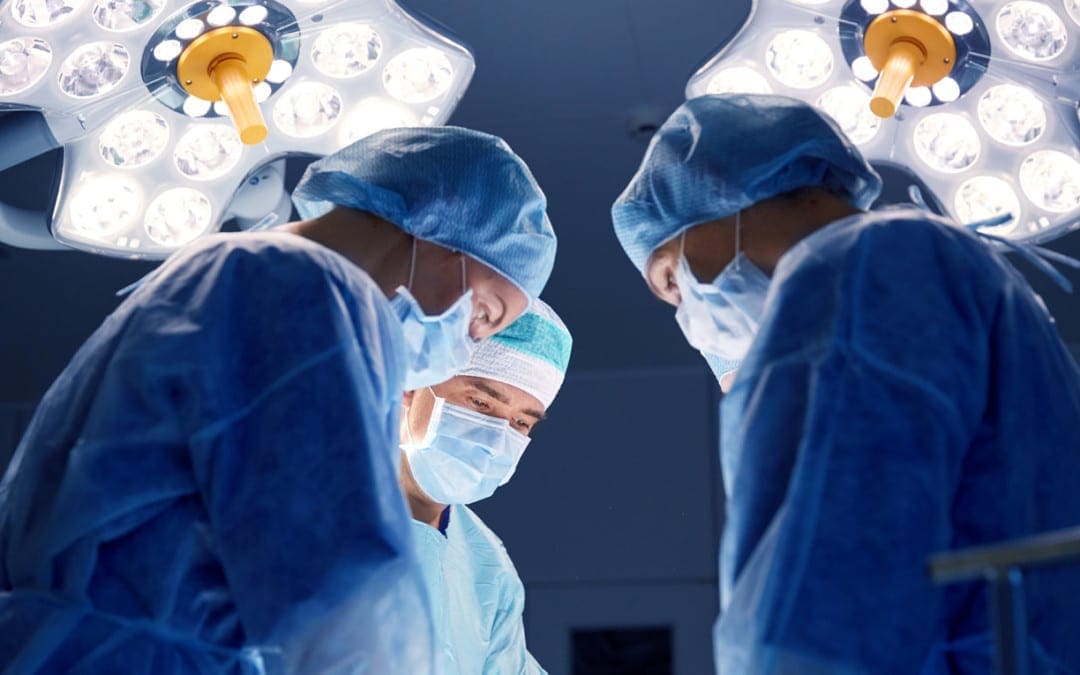
Times When Surgery for Sciatica Could Be Necessary
Surgery for sciatica is sometimes necessary if medications, chiropractic, and physical therapy are not working to relieve sciatica symptoms, but don�t worry. Individuals sometimes have sciatica that just does not respond to conservative treatment can find relief through surgical procedures.
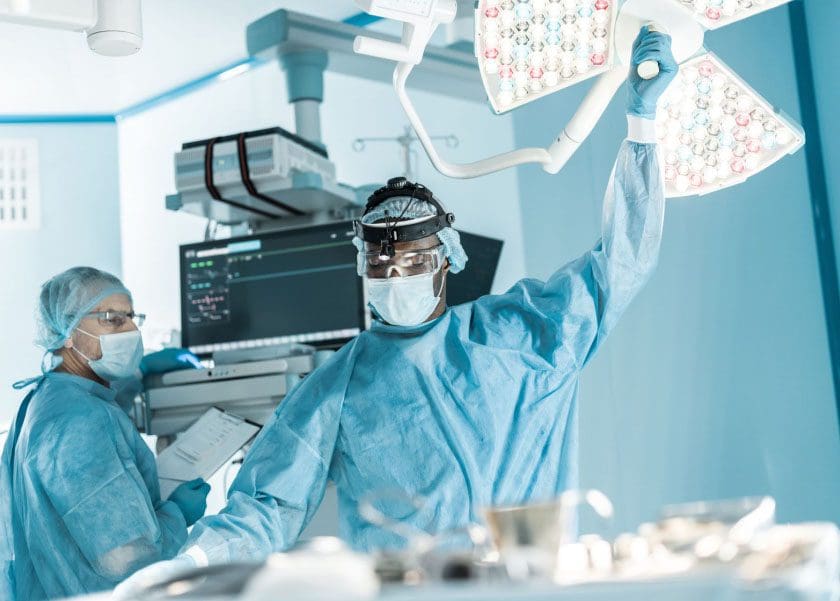
Questions begin to pop up, as to which procedure makes the most sense, what will the experience be like, and how long will it be until you can get back to a normal, pain-free life?
Contents
�
Sciatica
Sciatica is pain that runs down the longest nerve in the body, known as the sciatic nerve. Pain starts in the lower back and spreads down one leg, into the calf and possibly the foot. It is rare but sciatica can occur in both legs. The pain is mild to severe and feels worse when sneezing, coughing, bending, and standing/sitting in certain positions. The pain is often accompanied by numbness, tingling, or weakness in affected legs. �
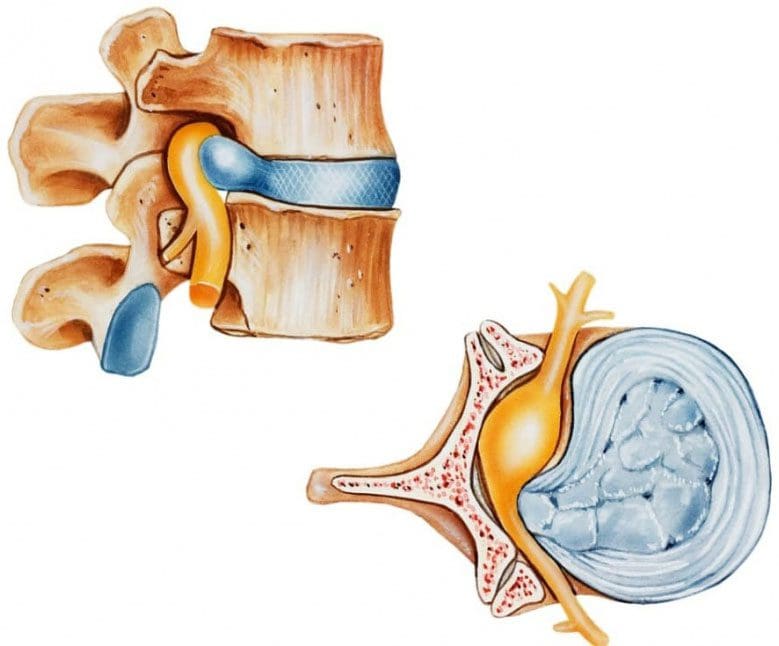
Sciatica a set of symptoms caused by other medical problems like an injury, tumor, or the most common cause around 90% of the time is a herniated disc in the lower back. The soft-gel center of the disc pushes through the tough exterior, where it can pinch or press on the sciatic nerve causing pain.
Research shows that sciatica affects 1% to 5% of the population, and around 40% will experience sciatica at some point in their life. Men between the ages of 30 and 50 have a higher risk along with smokers, individuals that sit for a long time, and those that perform physically strenuous work. Doctors and chiropractors can diagnose cases of sciatica with a medical history and physical exam. Diagnostic imaging can also be used in some cases.
�
When it’s Time to Consider Surgery for Sciatica

Most individuals with sciatica respond positively with non-surgical treatments like chiropractic, physical therapy, acupuncture, medication, spinal injection/s, etc. This makes spine surgery a rarely needed treatment for low back and leg pain caused by sciatic nerve compression. But there are situations when surgery for sciatica could be beneficial.
- With bowel or bladder dysfunction, this is also rare, but it can happen with spinal cord compression and cauda equina syndrome.
- Spinal stenosis, where the doctor believes that surgery is the best approach.
- There are neurologic dysfunctions like severe leg weakness
- Symptoms become severe and non-surgical treatment is no longer effective
There are different types of surgical procedures for spine surgery. A spine surgeon will recommend the best approach for each patient’s sciatica. Which procedure they recommend will be based on the disorder causing sciatica with the entire procedure clearly explained so that you understand completely. Ask any questions to better understand the surgeon’s recommendation. Remember, the final decision is always up to you. A second opinion is recommended before deciding.
Sciatica usually goes away on its own with the majority of cases managed with conservative treatment. Depending on the cause, this could be heat or ice packs, chiropractic, therapeutic massage, pain medication, stretching exercises, physical therapy, or injections. �
Sciatica for Surgery Options
Surgery for sciatica is performed to relieve the added compression/pressure on the nerves and relieve the pain. Options include a microdiscectomy and laminectomy. Each has its similarities and differences when it comes to the preparation, process, and recovery for the operation. �
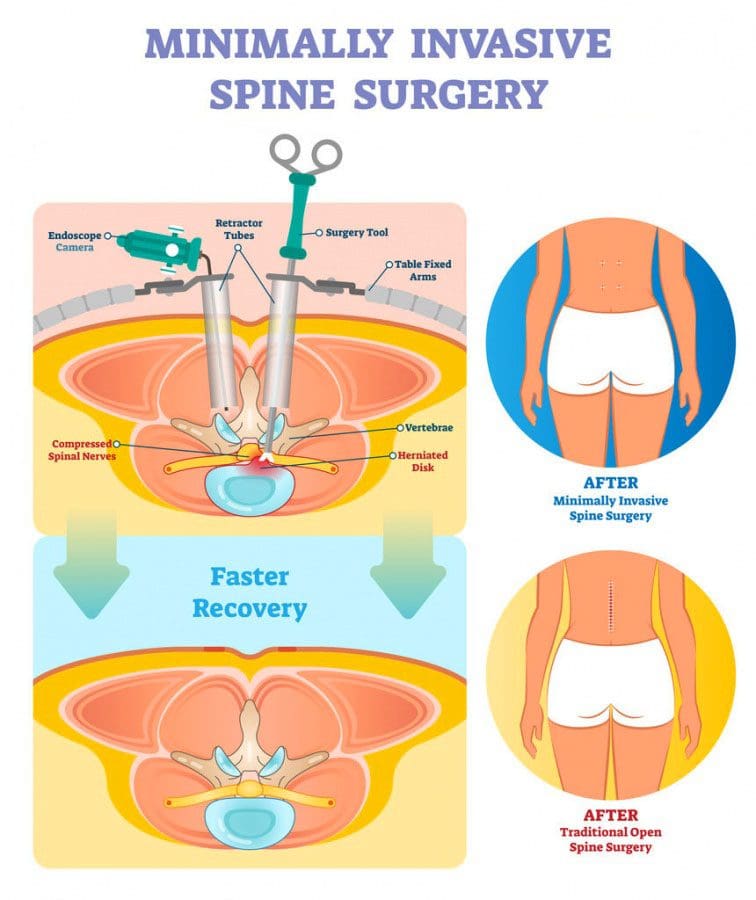
Microdiscectomy
During a microdiscectomy, part or all of the herniated disc is removed. Research has shown the effectiveness of relieving pain to be around 80 to 95 percent of patients. The operation is done in a hospital or surgery center and requires about one hour to complete. General anesthesia is administered during this procedure.
- A surgeon will make an incision over the affected disc.
- Skin and tissue covering the disc will be opened and moved for better access. Some of the bone could be taken out as part of the procedure called a laminotomy.
- The surgeon will use various tools to remove all or part of the herniated disc.
- Once the removal is done, the surgeon will close the incision and send you to a recovery room.
- To quicken the healing process patients are encouraged to start walking within hours of the procedure.
- Most go home the same day. Some patients will have to stay at the hospital for observation. This could be from other conditions present.
- You will not be allowed to operate a vehicle the same day. Therefore a designated driver will be necessary.
�
Laminectomy
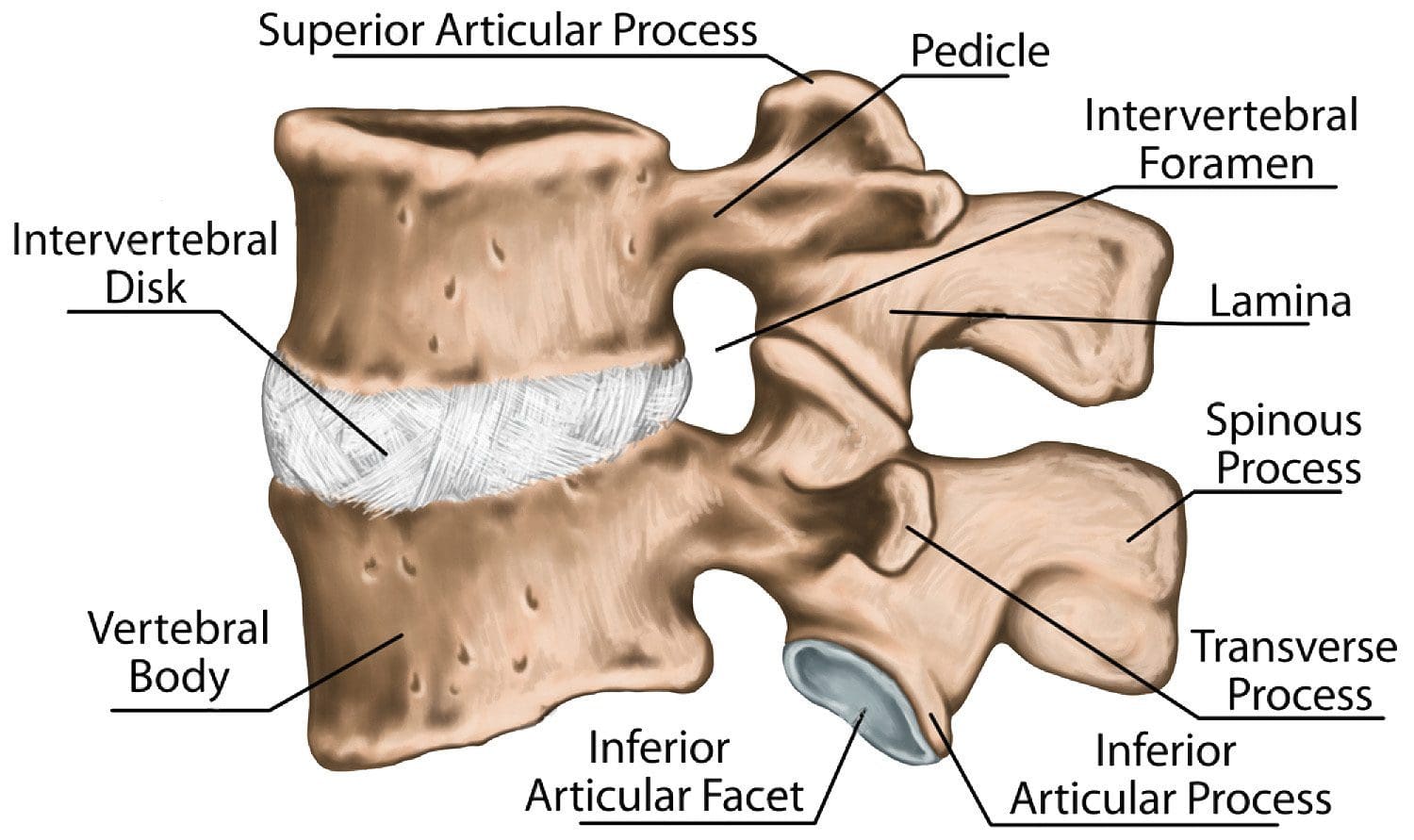
Preparation for a laminectomy is similar to a microdiscectomy. The lamina is the back part of the vertebrae, which protects the spinal canal. This procedure relieves pain by creating space for the nerves to move around.
- The procedure takes about one to three hours from start to finish.
- Both sides of the laminae are removed, along with the spinous process in the middle.
- The patient lies face-down as the surgeon makes an incision near the affected vertebrae.
- Skin and muscles are moved around and various tools/instruments are used to remove all or part of the lamina. Overgrowth of bone or spinal disc could also be removed.
- The incision is stitched or stapled, bandaged, and sent to a recovery room.
- Just like a microdiscectomy the individual will be encouraged to begin walking the same day.
- Most individuals leave the hospital after surgery, however, a one to possible three-night could be required for others.
- A driver does need to be designated for the ride home.
A microdiscectomy is recommended for stenosis caused by a herniated disc. However, if the stenosis is caused by another health issue/condition like bone spurs developed from arthritis, then a laminectomy could be the best approach. Laminectomies are usually performed on individuals in their 50s or 60s. While micro discectomies vary when it comes to age but are usually performed on younger individuals.
�
Recovery
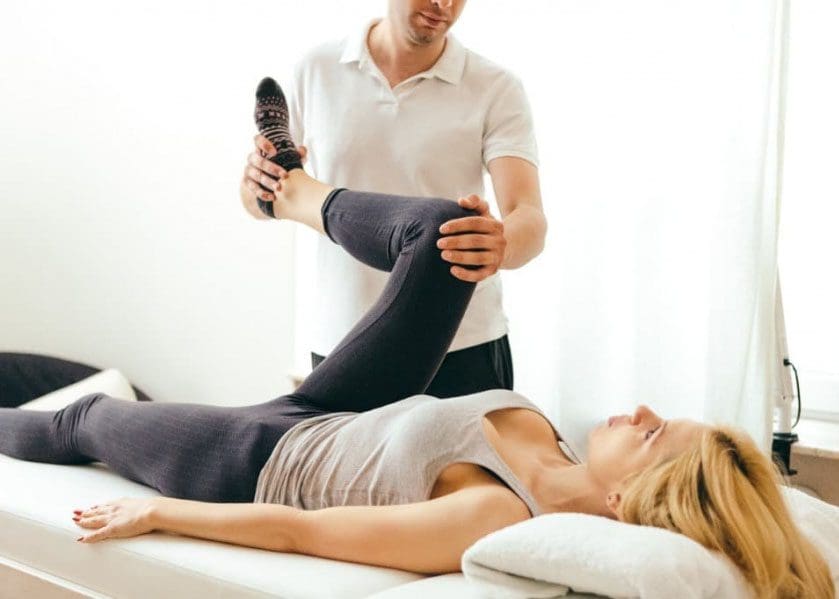
At home, post-op rules need to be followed no matter what surgery for sciatica was performed. The incision area needs to stay clean and no lifting of heavy objects, bending and sitting for extended times. Surgery for sciatica is considered safe with complications being uncommon. All operations come with risks. These include nerve damage, blood clots, and infection.
The provider needs to know about unusual symptoms after the procedure. This could be fever, excess drainage, or pain around the incision area. Pain meds could be prescribed to ease the post-surgery pain, and chiropractic along with physical therapy could be implemented to speed recovery. Individuals are typically cleared to return to work two to four weeks after the procedure. It could be six to eight weeks if their job/occupation is physically demanding and strenuous.
Depending on how complex the spine surgery is an individual could be sitting upright the same day and walking within 24 hours. A course of pain meds could be prescribed to help manage postoperative pain. Instructions will be given on how to sit, rise, get out of bed, and stand in a careful manner. The body needs time to heal, so a doctor could recommend activity restriction. This could be anything that moves the spine too much. For sure contact sports, twisting, or heavy lifting during recovery are to be avoided. Report any problem/s like fever, increased pain, infection right away.
�
Spine Surgery Relief
Many individuals benefit from sciatica surgery, but it doesn�t work for everyone. A small percentage of individuals continue to feel discomfort in the weeks/months after. And sciatica can return in the future and in a different location. Your healthcare provider can help you decide if surgery for sciatica is the right choice for you.
�
Treating Severe & Complex Sciatica Syndromes
�
Dr. Alex Jimenez�s Blog Post Disclaimer
The scope of our information is limited to chiropractic, musculoskeletal, physical medicines, wellness, and sensitive health issues and/or functional medicine articles, topics, and discussions. We use functional health & wellness protocols to treat and support care for injuries or disorders of the musculoskeletal system. Our posts, topics, subjects, and insights cover clinical matters, issues, and topics that relate and support directly or indirectly our clinical scope of practice.*
Our office has made a reasonable attempt to provide supportive citations and has identified the relevant research study or studies supporting our posts. We also make copies of supporting research studies available to the board and or the public upon request. We understand that we cover matters that require an additional explanation as to how it may assist in a particular care plan or treatment protocol; therefore, to further discuss the subject matter above, please feel free to ask Dr. Alex Jimenez or contact us at 915-850-0900. The provider(s) Licensed in Texas& New Mexico*

What is Degenerative Disc Disease (DDD)?: An Overview
Degenerative Disc Disease is a general term for a condition in which the damaged intervertebral disc causes chronic pain, which could be either low back pain in the lumbar spine or neck pain in the cervical spine. It is not a �disease� per se, but actually a breakdown of an intervertebral disc of the spine. The intervertebral disc is a structure that has a lot of attention being focused on recently, due to its clinical implications. The pathological changes that can occur in disc degeneration include fibrosis, narrowing, and disc desiccation. Various anatomical defects can also occur in the intervertebral disc such as sclerosis of the endplates, fissuring and mucinous degeneration of the annulus, and the formation of osteophytes. Low back pain and neck pain are major epidemiological problems, which are thought to be related to degenerative changes in the disk. Back pain is the second leading cause of the visit to the clinician in the USA. It is estimated that about 80% of US adults suffer from low back pain at least once during their lifetime. (Modic, Michael T., and Jeffrey S. Ross) Therefore, a thorough understanding of degenerative disc disease is needed for managing this common condition.Contents
Anatomy of Related Structures
Anatomy of the Spine
The spine is the main structure, which maintains the posture and gives rise to various problems with disease processes. The spine is composed of seven cervical vertebrae, twelve thoracic vertebrae, five lumbar vertebrae, and fused sacral and coccygeal vertebrae. The stability of the spine is maintained by three columns. The anterior column is formed by anterior longitudinal ligament and the anterior part of the vertebral body. The middle column is formed by the posterior part of the vertebral body and the posterior longitudinal ligament. The posterior column consists of a posterior body arch that has transverse processes, laminae, facets, and spinous processes. (�Degenerative Disk Disease: Background, Anatomy, Pathophysiology�)Anatomy of the Intervertebral Disc
Intervertebral disc lies between two adjacent vertebral bodies in the vertebral column. About one-quarter of the total length of the spinal column is formed by intervertebral discs. This disc forms a fibrocartilaginous joint, also called a symphysis joint. It allows a slight movement in the vertebrae and holds the vertebrae together. Intervertebral disc is characterized by its tension resisting and compression resisting qualities. An intervertebral disc is composed of mainly three parts; inner gelatinous nucleus pulposus, outer annulus fibrosus, and cartilage endplates that are located superiorly and inferiorly at the junction of vertebral bodies. Nucleus pulposus is the inner part that is gelatinous. It consists of proteoglycan and water gel held together by type II Collagen and elastin fibers arranged loosely and irregularly. Aggrecan is the major proteoglycan found in the nucleus pulposus. It comprises approximately 70% of the nucleus pulposus and nearly 25% of the annulus fibrosus. It can retain water and provides the osmotic properties, which are needed to resist compression and act as a shock absorber. This high amount of aggrecan in a normal disc allows the tissue to support compressions without collapsing and the loads are distributed equally to annulus fibrosus and vertebral body during movements of the spine. (Wheater, Paul R, et al.) The outer part is called annulus fibrosus, which has abundant type I collagen fibers arranged as a circular layer. The collagen fibers run in an oblique fashion between lamellae of the annulus in alternating directions giving it the ability to resist tensile strength. Circumferential ligaments reinforce the annulus fibrosus peripherally. On the anterior aspect, a thick ligament further reinforces annulus fibrosus and a thinner ligament reinforces the posterior side. (Choi, Yong-Soo) Usually, there is one disc between every pair of vertebrae except between atlas and axis, which are first and second cervical vertebrae in the body. These discs can move about 6? in all the axes of movement and rotation around each axis. But this freedom of movement varies between different parts of the vertebral column. The cervical vertebrae have the greatest range of movement because the intervertebral discs are larger and there is a wide concave lower and convex upper vertebral body surfaces. They also have transversely aligned facet joints. Thoracic vertebrae have the minimum range of movement in flexion, extension, and rotation, but have free lateral flexion as they are attached to the rib cage. The lumbar vertebrae have good flexion and extension, again, because their intervertebral discs are large and spinous processes are posteriorly located. However, lateral lumbar rotation is limited because the facet joints are located sagittally. (�Degenerative Disk Disease: Background, Anatomy, Pathophysiology�)Blood Supply
The intervertebral disc is one of the largest avascular structures in the body with capillaries terminating at the endplates. The tissues derive nutrients from vessels in the subchondral bone which lie adjacent to the hyaline cartilage at the endplate. These nutrients such as oxygen and glucose are carried to the intervertebral disc through simple diffusion. (�Intervertebral Disc � Spine � Orthobullets.Com�)Nerve Supply
Sensory innervation of intervertebral discs is complex and varies according to the location in the spinal column. Sensory transmission is thought to be mediated by substance P, calcitonin, VIP, and CPON. Sinu vertebral nerve, which arises from the dorsal root ganglion, innervates the superficial fibers of the annulus. Nerve fibers don�t extend beyond the superficial fibers. Lumbar intervertebral discs are additionally supplied on the posterolateral aspect with branches from ventral primary rami and from the grey rami communicantes near their junction with the ventral primary rami. The lateral aspects of the discs are supplied by branches from rami communicantes. Some of the rami communicantes may cross the intervertebral discs and become embedded in the connective tissue, which lies deep to the origin of the psoas. (Palmgren, Tove, et al.) The cervical intervertebral discs are additionally supplied on the lateral aspect by branches of the vertebral nerve. The cervical sinu vertebral nerves were also found to be having an upward course in the vertebral canal supplying the disc at their point of entry and the one above. (BOGDUK, NIKOLAI, et al.)Pathophysiology of Degenerative Disc Disease
Approximately 25% of people before the age of 40 years show disc degenerative changes at some level. Over 40 years of age, MRI evidence shows changes in more than 60% of people. (Suthar, Pokhraj) Therefore, it is important to study the degenerative process of the intervertebral discs as it has been found to degenerate faster than any other connective tissue in the body, leading to back and neck pain. The changes in three intervertebral discs are associated with changes in the vertebral body and joints suggesting a progressive and dynamic process.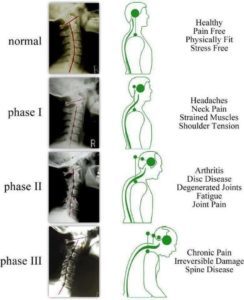 The degenerative process of the intervertebral discs has been divided into three stages, according to Kirkaldy-Willis and Bernard, called ��degenerative cascade��. These stages can overlap and can occur over the course of decades. However, identifying these stages clinically is not possible due to the overlap of symptoms and signs.
The degenerative process of the intervertebral discs has been divided into three stages, according to Kirkaldy-Willis and Bernard, called ��degenerative cascade��. These stages can overlap and can occur over the course of decades. However, identifying these stages clinically is not possible due to the overlap of symptoms and signs.
Stage 1 (Degeneration Phase)
This stage is characterized by degeneration. There are histological changes, which show circumferential tears and fissures in the annulus fibrosus. These circumferential tears may turn into radial tears and because the annulus pulposus is well innervated, these tears can cause back pain or neck pain, which is localized and with painful movements. Due to repeated trauma in the discs, endplates can separate leading to disruption of the blood supply to the disc and therefore, depriving it of its nutrient supply and removal of waste. The annulus may contain micro-fractures in the collagen fibrils, which can be seen on electron microscopy and an MRI scan may reveal desiccation, bulging of the disc, and a high-intensity zone in the annulus. Facet joints may show a synovial reaction and it may cause severe pain with associated synovitis and inability to move the joint in the zygapophyseal joints. These changes may not necessarily occur in every person. (Gupta, Vijay Kumar, et al.) The nucleus pulposus is also involved in this process as its water imbibing capacity is reduced due to the accumulation of biochemically changed proteoglycans. These changes are brought on mainly by two enzymes called matrix metalloproteinase-3 (MMP-3) and tissue inhibitor of metalloproteinase-1 (TIMP-1). (Bhatnagar, Sushma, and Maynak Gupta) Their imbalance leads to the destruction of proteoglycans. The reduced capacity to absorb water leads to a reduction of hydrostatic pressure in the nucleus pulposus and causes the annular lamellae to buckle. This can increase the mobility of that segment resulting in shear stress to the annular wall. All these changes can lead to a process called annular delamination and fissuring in the annulus fibrosus. These are two separate pathological processes and both can lead to pain, local tenderness, hypomobility, contracted muscles, painful joint movements. However, the neurological examination at this stage is usually normal.Stage 2 (Phase of Instability)
The stage of dysfunction is followed by a stage of instability, which may result from the progressive deterioration of the mechanical integrity of the joint complex. There may be several changes encountered at this stage, including disc disruption and resorption, which can lead to a loss of disc space height. Multiple annular tears may also occur at this stage with concurrent changes in the zagopophyseal joints. They may include degeneration of the cartilage and facet capsular laxity leading to subluxation. These biomechanical changes result in instability of the affected segment. The symptoms seen in this phase are similar to those seen in the dysfunction phase such as �giving way� of the back, pain when standing for prolonged periods, and a �catch� in the back with movements. They are accompanied by signs such as abnormal movements in the joints during palpation and observing that the spine sways or shifts to a side after standing erect for sometime after flexion. (Gupta, Vijay Kumar et al.)Stage 3 (Re-Stabilization Phase)
In this third and final stage, the progressive degeneration leads to disc space narrowing with fibrosis and osteophyte formation and transdiscal bridging. The pain arising from these changes is severe compared to the previous two stages, but these can vary between individuals. This disc space narrowing can have several implications on the spine. This can cause the intervertebral canal to narrow in the superior-inferior direction with the approximation of the adjacent pedicles. Longitudinal ligaments, which support the vertebral column, may also become deficient in some areas leading to laxity and spinal instability. The spinal movements can cause the ligamentum flavum to bulge and can cause superior aricular process subluxation. This ultimately leads to a reduction of diameter in the anteroposterior direction of the intervertebral space and stenosis of upper nerve root canals. Formation of osteophytes and hypertrophy of facets can occur due to the alteration in axial load on the spine and vertebral bodies. These can form on both superior and inferior articular processes and osteophytes can protrude to the intervertebral canal while the hypertrophied facets can protrude to the central canal. Osteophytes are thought to be made from the proliferation of articular cartilage at the periosteum after which they undergo endochondral calcification and ossification. The osteophytes are also formed due to the changes in oxygen tension and due to changes in fluid pressure in addition to load distribution defects. The osteophytes and periarticular fibrosis can result in stiff joints. The articular processes may also orient in an oblique direction causing retrospondylolisthesis leading to the narrowing of the intervertebral canal, nerve root canal, and the spinal canal. (KIRKALDY-WILLIS, W H et al.) All of these changes lead to low back pain, which decreases with severity. Other symptoms like reduced movement, muscle tenderness, stiffness, and scoliosis can occur. The synovial stem cells and macrophages are involved in this process by releasing growth factors and extracellular matrix molecules, which act as mediators. The release of cytokines has been found to be associated with every stage and may have therapeutic implications in future treatment development.Etiology of the Risk Factors of Degenerative Disc Disease
Aging and Degeneration
It is difficult to differentiate aging from degenerative changes. Pearce et al have suggested that aging and degeneration is representing successive stages within a single process that occur in all individuals but at different rates. Disc degeneration, however, occurs most often at a faster rate than aging. Therefore, it is encountered even in patients of working age. There appears to be a relationship between aging and degeneration, but no distinct cause has yet been established. Many studies have been conducted regarding nutrition, cell death, and accumulation of degraded matrix products and the failure of the nucleus. The water content of the intervertebral disc decreases with the increasing age. Nucleus pulposus can get fissures that can extend into the annulus fibrosus. The start of this process is termed chondrosis inter vertebralis, which can mark the beginning of the degenerative destruction of the intervertebral disc, the endplates, and the vertebral bodies. This process causes complex changes in the molecular composition of the disc and has biomechanical and clinical sequelae that can often result in substantial impairment in the affected individual. The cell concentration in the annulus decreases with increasing age. This is mainly because the cells in the disc are subjected to senescence and they lose the ability to proliferate. Other related causes of age-specific degeneration of intervertebral discs include cell loss, reduced nutrition, post-translational modification of matrix proteins, accumulation of products of degraded matrix molecules, and fatigue failure of the matrix. Decreasing nutrition to the central disc, which allows the accumulation of cell waste products and degraded matrix molecules seems to be the most important change out of all these changes. This impairs nutrition and causes a fall in the pH level, which can further compromise cell function and may lead to cell death. Increased catabolism and decreased anabolism of senescent cells may promote degeneration. (Buckwalter, Joseph A.) According to one study, there were more senescence cells in the nucleus pulposus compared to annulus fibrosus and herniated discs had a higher chance of cell senescence.� (Roberts, S. et al.) When the aging process goes on for some time, the concentrations of chondroitin 4 sulfate and chondroitin 5 sulfate, which is strongly hydrophilic, gets decreased while the keratin sulfate to chondroitin sulfate ratio gets increased. Keratan sulfate is mildly hydrophilic and it also has a minor tendency to form stable aggregates with hyaluronic acid. As aggrecan is fragmented, and its molecular weight and numbers are decreased, the viscosity and hydrophilicity of the nucleus pulposus decrease. Degenerative changes to the intervertebral discs are accelerated by the reduced hydrostatic pressure of the nucleus pulposus and the decreased supply of nutrients by diffusion. When the water content of the extracellular matrix is decreased, intervertebral disc height will also be decreased. The resistance of the disc to an axial load will also be reduced. Because the axial load is then transferred directly to the annulus fibrosus, annulus clefts can get torn easily. All these mechanisms lead to structural changes seen in degenerative disc disease. Due to the reduced water content in the annulus fibrosus and associated loss of compliance, the axial load can get redistributed to the posterior aspect of facets instead of the normal anterior and middle part of facets. This can cause facet arthritis, hypertrophy of the adjacent vertebral bodies, and bony spurs or bony overgrowths, known as osteophytes, as a result of degenerative discs. (Choi, Yong-Soo)Genetics and Degeneration
The genetic component has been found to be a dominant factor in degenerative disc disease. Twin studies, and studies involving mice, have shown that genes play a role in disc degeneration. (Boyd, Lawrence M., et al.) Genes that code for collagen I, IX, and XI, interleukin 1, aggrecan, vitamin D receptor, matrix metalloproteinase 3 (MMP � 3), and other proteins are among the genes that are suggested to be involved in degenerative disc disease. Polymorphisms in 5 A and 6 A alleles occurring in the promoter region of genes that regulate MMP 3 production are found to be a major factor for the increased lumbar disc degeneration in the elderly population. Interactions among these various genes contribute significantly to intervertebral disc degeneration disease as a whole.Nutrition and Degeneration
Disc degeneration is also believed to occur due to the failure of nutritional supply to the intervertebral disc cells. Apart from the normal aging process, the nutritional deficiency of the disc cells is adversely affected by endplate calcification, smoking, and the overall nutritional status. Nutritional deficiency can lead to the formation of lactic acid together with the associated low oxygen pressure. The resulting low pH can affect the ability of disc cells to form and maintain the extracellular matrix of the discs and causes intervertebral disc degeneration. The degenerated discs lack the ability to respond normally to the external force and may lead to disruptions even from the slightest back strain. (Taher, Fadi, et al.) Growth factors stimulate the chondrocytes and fibroblasts to produce more amount of extracellular matrix. It also inhibits the synthesis of matrix metalloproteinases. Example of these growth factors includes transforming growth factor, insulin-like growth factor, and basic fibroblast growth factor. The degraded matrix is repaired by an increased level of transforming growth factor and basic fibroblast growth factor.Environment and Degeneration
Even though all the discs are of the same age, discs found in the lower lumbar segments are more vulnerable to degenerative changes than the discs found in the upper segment. This suggests that not only aging but, also mechanical loading, is a causative factor. The association between degenerative disc disease and environmental factors has been defined in a comprehensive manner by Williams and Sambrook in 2011. (Williams, F.M.K., and P.N. Sambrook) The heavy physical loading associated with your occupation is a risk factor that has some contribution to disc degenerative disease. There is also a possibility of chemicals causing disc degeneration, such as smoking, according to some studies. (Batti�, Michele C.) Nicotine has been implicated in twin studies to cause impaired blood flow to the intervertebral disc, leading to disc degeneration. (BATTI�, MICHELE C., et al.) Moreover, an association has been found among atherosclerotic lesions in the aorta and the low back pain citing a link between atherosclerosis and degenerative disc disease. (Kauppila, L.I.) The disc degeneration severity was implicated in overweight, obesity, metabolic syndrome, and increased body mass index in some studies. (�A Population-Based Study Of Juvenile Disc Degeneration And Its Association With Overweight And Obesity, Low Back Pain, And Diminished Functional Status. Samartzis D, Karppinen J, Mok F, Fong DY, Luk KD, Cheung KM. J Bone Joint Surg Am 2011;93(7):662�70�)Pain in Disc Degeneration (Discogenic Pain)
Discogenic pain, which is a type of nociceptive pain, arises from the nociceptors in the annulus fibrosus when the nervous system is affected by the degenerative disc disease. Annulus fibrosus contains immune reactive nerve fibers in the outer layer of the disc with other chemicals such as a vasoactive intestinal polypeptide, calcitonin gene-related peptide, and substance P. (KONTTINEN, YRJ� T., et al.) When degenerative changes in the intervertebral discs occur, normal structure and mechanical load are changed leading to abnormal movements. These disc nociceptors can get abnormally sensitized to mechanical stimuli. The pain can also be provoked by the low pH environment caused by the presence of lactic acid, causing increased production of pain mediators. Pain from degenerative disc disease may arise from multiple origins. It may occur due to the structural damage, pressure, and irritation on the nerves in the spine. The disc itself contains only a few nerve fibers, but any injury can sensitize these nerves, or those in the posterior longitudinal ligament, to cause pain. Micro movements in the vertebrae can occur, which may cause painful reflex muscle spasms because the disc is damaged and worn down with the loss of tension and height. The painful movements arise because the nerves supplying the area are compressed or irritated by the facet joints and ligaments in the foramen leading to leg and back pain. This pain may be aggravated by the release of inflammatory proteins that act on nerves in the foramen or descending nerves in the spinal canal. Pathological specimens of the degenerative discs, when observed under the microscope, reveals that there are vascularized granulation tissue and extensive innervations found in the fissures of the outer layer of the annulus fibrosus extending into the nucleus pulposus. The granulation tissue area is infiltrated by abundant mast cells and they invariably contribute to the pathological processes that ultimately lead to discogenic pain. These include neovascularisation, intervertebral disc degeneration, disc tissue inflammation, and the formation of fibrosis. Mast cells also release substances, such as tumor necrosis factor and interleukins, which might signal for the activation of some pathways which play a role in causing back pain. Other substances that can trigger these pathways include phospholipase A2, which is produced from the arachidonic acid cascade. It is found in increased concentrations in the outer third of the annulus of the degenerative disc and is thought to stimulate the nociceptors located there to release inflammatory substances to trigger pain. These substances bring about axonal injury, intraneural edema, and demyelination. (Brisby, Helena) The back pain is thought to arise from the intervertebral disc itself. Hence why the pain will decrease gradually over time when the degenerating disc stops inflicting pain. However, the pain actually arises from the disc itself only in 11% of patients according to endoscopy studies. The actual cause of back pain seems to be due to the stimulation of the medial border of the nerve and referred pain along the arm or leg seems to arise due to the stimulation of the core of the nerve. The treatment for disc degeneration should mainly focus on pain relief to reduce the suffering of the patient because it is the most disabling symptom that disrupts a patient�s lives. Therefore, it is important to establish the mechanism of pain because it occurs not only due to the structural changes in the intervertebral discs but also due to other factors such as the release of chemicals and understanding these mechanisms can lead to effective pain relief. (Choi, Yong-Soo)Clinical Presentation of Degenerative Disc Disease
Patients with degenerative disc disease face a myriad of symptoms depending on the site of the disease. Those who have lumbar disc degeneration get low back pain, radicular symptoms, and weakness. Those who have cervical disc degeneration have neck pain and shoulder pain. Low back pain can get exacerbated by the movements and the position. Usually, the symptoms are worsened by the flexion, while the extension often relieves them. Minor twisting injuries, even from swinging a golf club, can trigger the symptoms. The pain is usually observed to be less when walking or running, when changing the position frequently and when lying down. However, the pain is usually subjective and in many cases, it varies considerably from person to person and most people will suffer from a low level of chronic pain of the lower back region continuously while occasionally suffering from the groin, hip, and leg pain. The intensity of the pain will increase from time to time and will last for a few days and then subside gradually. This �flare-up� is an acute episode and needs to be treated with potent analgesics. Worse pain is experienced in the seated position and is exacerbated while bending, lifting, and twisting movements frequently. The severity of the pain can vary considerably with some having occasional nagging pain to others having severe and disabling pain intermittently.� (Jason M. Highsmith, MD) The localized pain and tenderness in the axial spine usually arises from the nociceptors found within the intervertebral discs, facet joints, sacroiliac joints, dura mater of the nerve roots, and the myofascial structures found within the axial spine. As mentioned in the previous sections, the degenerative anatomical changes may result in a narrowing of the spinal canal called spinal stenosis, overgrowth of spinal processes called osteophytes, hypertrophy of the inferior and superior articular processes, spondylolisthesis, bulging of the ligamentum flavum and disc herniation. These changes result in a collection of symptoms that is known as neurogenic claudication. There may be symptoms such as low back pain and leg pain together with numbness or tingling in the legs, muscle weakness, and foot drop. Loss of bowel or bladder control may suggest spinal cord impingement and prompt medical attention is needed to prevent permanent disabilities. These symptoms can vary in severity and may present to varying extents in different individuals. The pain can also radiate to other parts of the body due to the fact that the spinal cord gives off several branches to two different sites of the body. Therefore, when the degenerated disc presses on a spinal nerve root, the pain can also be experienced in the leg to which the nerve ultimately innervates. This phenomenon, called radiculopathy, can occur from many sources arising, due to the process of degeneration. The bulging disc, if protrudes centrally, can affect descending rootlets of the cauda equina, if it bulges posterolaterally, it might affect the nerve roots exiting at the next lower intervertebral canal and the spinal nerve within its ventral ramus can get affected when the disc protrudes laterally. Similarly, the osteophytes protruding along the upper and lower margins of the posterior aspect of vertebral bodies can impinge on the same nervous tissues causing the same symptoms. Superior articular process hypertrophy may also impinge upon nerve roots depending on their projection. The nerves may include nerve roots prior to exiting from the next lower intervertebral canal and nerve roots within the upper nerve root canal and dural sac. These symptoms, due to the nerve impingement, have been proven by cadaver studies. Neural compromise is thought to occur when the neuro foraminal diameter is critically occluded with a 70% reduction. Furthermore, neural compromise can be produced when the posterior disc is compressed less than 4 millimeters in height, or when the foraminal height is reduced to less than 15 millimeters leading to foraminal stenosis and nerve impingement. (Taher, Fadi, et al.)Diagnostic Approach
Patients are initially evaluated with an accurate history and thorough physical examination and appropriate investigations and provocative testing. However, history is often vague due to the chronic pain which cannot be localized properly and the difficulty in determining the exact anatomical location during provocative testing due to the influence of the neighboring anatomical structures. Through the patient�s history, the cause of low back pain can be identified as arising from the nociceptors in the intervertebral discs. Patients may also give a history of the chronic nature of the symptoms and associated gluteal region numbness, tingling as well as stiffness in the spine which usually worsens with activity. Tenderness may be elicited by palpating over the spine. Due to the nature of the disease being chronic and painful, most patients may be suffering from mood and anxiety disorders. Depression is thought to be contributing negatively to the disease burden. However, no clear relationship between disease severity and mood or anxiety disorders. It is good to be vigilant about these mental health conditions as well. In order to exclude other serious pathologies, questions must be asked regarding fatigue, weight loss, fever, and chills, which might indicate some other diseases. (Jason M. Highsmith, MD) Another etiology for the low back pain has to be excluded when examining the patient for degenerative disc disease. Abdominal pathologies, which can give rise to back pain such as aortic aneurysm, renal calculi, and pancreatic disease, have to be excluded. Degenerative disc disease has several differential diagnoses to be considered when a patient presents with back pain. These include; idiopathic low back pain, zygapophyseal joint degeneration, myelopathy, lumbar stenosis, spondylosis, osteoarthritis, and lumbar radiculopathy. (�Degenerative Disc Disease � Physiopedia�)Investigations
Investigations are used to confirm the diagnosis of degenerative disc disease. These can be divided into laboratory studies, imaging studies, nerve conduction tests, and diagnostic procedures. Imaging Studies The imaging in degenerative disc disease is mainly used to describe anatomical relations and morphological features of the affected discs, which has a great therapeutic value in future decision making for treatment options. Any imaging method, like plain radiography, CT, or MRI, can provide useful information. However, an underlying cause can only be found in 15% of the patients as no clear radiological changes are visible in degenerative disc disease in the absence of disc herniation and neurological deficit. Moreover, there is no correlation between the anatomical changes seen on imaging and the severity of the symptoms, although there are correlations between the number of osteophytes and the severity of back pain. Degenerative changes in radiography can also be seen in asymptomatic people leading to difficulty in conforming clinical relevance and when to start treatment. (�Degenerative Disc Disease � Physiopedia�) Plain Radiography This inexpensive and widely available plain cervical radiography can give important information on deformities, alignment, and degenerative bony changes. In order to determine the presence of spinal instability and sagittal balance, dynamic flexion, or extension studies have to be performed. Magnetic Resonance Imaging (MRI) MRI is the most commonly used method to diagnose degenerative changes in the intervertebral disc accurately, reliably, and most comprehensively. It is used in the initial evaluation of patients with neck pain after plain radiography. It can provide non-invasive images in multiple plains and gives excellent quality images of the disc. MRI can show disc hydration and morphology-based on the proton density, chemical environment, and the water content. Clinical picture and history of the patient have to be considered when interpreting MRI reports as it has been shown that as much as 25% of radiologists change their report when the clinical data are available. Fonar produced the first open MRI scanner with the ability of the patient to be scanned in different positions such as standing, sitting, and bending. Because of these unique features, this open MRI scanner can be used for scanning patients in weight-bearing postures and stand up postures to detect underlying pathological changes which are usually overlooked in conventional MRI scan such as lumbar degenerative disc disease with herniation. This machine is also good for claustrophobic patients, as they get to watch a large television screen during the scanning process. (�Degenerative Disk Disease: Background, Anatomy, Pathophysiology.�) Nucleus pulposus and annulus fibrosus of the disc can usually be identified on MRI, leading to the detection of disc herniation as contained and non contained. As MRI can also show annular tears and the posterior longitudinal ligament, it can be used to classify herniation. This can be simple annular bulging to free fragment disc herniations. This information can describe the pathologic discs such as extruded disc, protruded discs, and migrated discs. There are several grading systems based on MRI signal intensity, disc height, the distinction between nucleus and annulus, and the disc structure. The method, by Pfirrmann et al, has been widely applied and clinically accepted. According to the modified system, there are 8 grades for lumbar disc degenerative disease. Grade 1 represents normal intervertebral disc and grade 8 corresponds to the end stage of degeneration, depicting the progression of the disc disease. There are corresponding images to aid the diagnosis. As they provide good tissue differentiation and detailed description of the disc structure, sagittal T2 weighted images are used for the classification purpose. (Pfirrmann, Christian W. A., et al.) Modic has described the changes occurring in the vertebral bodies adjacent to the degenerating discs as Type 1 and Type 2 changes. In Modic 1 changes, there is decreased intensity of T1 weighted images and increased intensity T2 weighted images. This is thought to occur because the end plates have undergone sclerosis and the adjacent bone marrow is showing inflammatory response as the diffusion coefficient increases. This increase of diffusion coefficient and the ultimate resistance to diffusion is brought about by the chemical substances released through an autoimmune mechanism. Modic type 2 changes include the destruction of the bone marrow of adjacent vertebral endplates due to an inflammatory response and the infiltration of fat in the marrow. These changes may lead to increased signal density on T1 weighted images. (Modic, M T et al.) Computed Tomography (CT) When MRI is not available, Computed tomography is considered a diagnostic test that can detect disc herniation because it has a better contrast between posterolateral margins of the adjacent bony vertebrae, perineal fat, and the herniated disc material. Even so, when diagnosing lateral herniations, MRI remains the imaging modality of choice. CT scan has several advantages over MRI such as it has a less claustrophobic environment, low cost, and better detection of bonny changes that are subtle and may be missed on other modalities. CT can detect early degenerative changes of the facet joints and spondylosis with more accuracy. Bony integrity after fusion is also best assessed by CT. Disc herniation and associated nerve impingement can be diagnosed by using the criteria developed by Gundry and Heithoff. It is important for the disc protrusion to lie directly over the nerve roots traversing the disc and to be focal and asymmetrical with a dorsolateral position. There should be demonstrable nerve root compression or displacement. Lastly, the nerve distal to the impingement (site of herniation) often enlarges and bulges with resulting edema, prominence of adjacent epidural veins, and inflammatory exudates resulting in blurring the margin. Lumbar Discography This procedure is controversial and, whether knowing the site of the pain has any value regarding surgery or not, has not been proven. False positives can occur due to central hyperalgesia in patients with chronic pain (neurophysiologic finding) and due to psychosocial factors. It is questionable to establish exactly when discogenic pain becomes clinically significant. Those who support this investigation advocates strict criteria for selection of the patients and when interpreting results and believe this is the only test that can diagnose discogenic pain. Lumbar discography can be used in several situations, although it is not scientifically established. These include; diagnosis of lateral herniation, diagnosing a symptomatic disc among multiple abnormalities, assessing similar abnormalities seen on CT or MRI, evaluation of the spine after surgery, selection of fusion level, and the suggestive features of discogenic pain existence. The discography is more concerned about eliciting pathophysiology rather than determining the anatomy of the disc. Therefore, discogenic pain evaluation is the aim of discography. MRI may reveal an abnormally looking disc with no pain, while severe pain may be seen on discography where MRI findings are few. During the injection of normal saline or the contrast material, a spongy endpoint can occur with abnormal discs accepting more amounts of contrast. The contrast material can extend into the nucleus pulposus through tears and fissures in the annulus fibrosus in the abnormal discs. The pressure of this contrast material can provoke pain due to the innervations by recurrent meningeal nerve, mixed spinal nerve, anterior primary rami, and gray rami communicantes supplying the outer annulus fibrosus. Radicular pain can be provoked when the contrast material reaches the site of nerve root impingement by the abnormal disc. However, this discography test has several complications such as nerve root injury, chemical or bacterial diskitis, contrast allergy, and the exacerbation of pain. (Bartynski, Walter S., and A. Orlando Ortiz) Imaging Modality Combination In order to evaluate the nerve root compression and cervical stenosis adequately, a combination of imaging methods may be needed. CT Discography After performing initial discography, CT discography is performed within 4 hours. It can be used in determining the status of the disc such as herniated, protruded, extruded, contained or sequestered. It can also be used in the spine to differentiate the mass effects of scar tissue or disc material after spinal surgery. CT Myelography This test is considered the best method for evaluating nerve root compression. When CT is performed in combination or after myelography, details about bony anatomy different planes can be obtained with relative ease.Diagnostic Procedures
Transforaminal Selective Nerve Root Blocks (SNRBs)
When multilevel degenerative disc disease is suspected on an MRI scan, this test can be used to determine the specific nerve root that has been affected. SNRB is both a diagnostic and therapeutic test that can be used for lumbar spinal stenosis. The test creates a demotomal level area of hypoesthesia by injecting an anesthetic and a contrast material under fluoroscopic guidance to the interested nerve root level. There is a correlation between multilevel cervical degenerative disc disease clinical symptoms and findings on MRI and findings of SNRB according to Anderberg et al. There is a 28% correlation with SNRB results and with dermatomal radicular pain and areas of neurologic deficit. Most severe cases of degeneration on MRI are found to be correlated with 60%. Although not used routinely, SNRB is a useful test in evaluating patients before surgery in multilevel degenerative disc disease especially on the spine together with clinical features and findings on MRI. (Narouze, Samer, and Amaresh Vydyanathan)Electro Myographic Studies
Distal motor and sensory nerve conduction tests, called electromyographic studies, that are normal with abnormal needle exam may reveal nerve compression symptoms that are elicited in the clinical history. Irritated nerve roots can be localized by using injections to anesthetize the affected nerves or pain receptors in the disc space, sacroiliac joint, or the facet joints by discography. (�Journal Of Electromyography & Kinesiology Calendar�) Laboratory Studies Laboratory tests are usually done to exclude other differential diagnoses. As seronegative spondyloarthropathies, such as ankylosing spondylitis, are common causes of back pain, HLA B27 immuno-histocompatibility has to be tested. Estimated 350,000 persons in the US and 600,000 in Europe have been affected by this inflammatory disease of unknown etiology. But HLA B27 is extremely rarely found in African Americans. Other seronegative spondyloarthropathies that can be tested using this gene include psoriatic arthritis, inflammatory bowel disease, and reactive arthritis or Reiter syndrome. Serum immunoglobulin A (IgA) can be increased in some patients. Tests like the erythrocyte sedimentation rate (ESR) and C- reactive protein (CRP) level test for the acute phase reactants seen in inflammatory causes of lower back pain such as osteoarthritis and malignancy. The full blood count is also required, including differential counts to ascertain the disease etiology. Autoimmune diseases are suspected when Rheumatoid factor (RF) and anti-nuclear antibody (ANA) tests become positive. Serum uric acid and synovial fluid analysis for crystals may be needed in rare cases to exclude gout and pyrophosphate dihydrate deposition.Treatment
There is no definitive treatment method agreed by all physicians regarding the treatment of degenerative disc disease because the cause of the pain can differ in different individuals and so is the severity of pain and the wide variations in clinical presentation. The treatment options can be discussed broadly under; conservative treatment, medical treatment, and surgical treatment.Conservative Treatment
This treatment method includes exercise therapy with behavioral interventions, physical modalities, injections, back education, and back school methods.Exercise-Based Therapy with Behavioral Interventions
Depending on the diagnosis of the patient, different types of exercises can be prescribed. It is considered one of the main methods of conservative management to treat chronic low back pain. The exercises can be modified to include stretching exercises, aerobic exercises, and muscle strengthening exercises. One of the major challenges of this therapy includes its inability to assess the efficacy among patients due to wide variations in the exercise regimens, frequency, and intensity. According to studies, most effectiveness for sub-acute low back pain with varying duration of symptoms was obtained by performing graded exercise programs within the occupational setting of the patient. Significant improvements were observed among patients suffering from chronic symptoms with this therapy with regard to functional improvement and pain reduction. Individual therapies designed for each patient under close supervision and compliance of the patient also seems to be the most effective in chronic back pain sufferers. Other conservative approaches can be used in combination to improve this approach. (Hayden, Jill A., et al.) Aerobic exercises, if performed regularly, can improve endurance. For relieving muscle tension, relaxation methods can be used. Swimming is also considered an exercise for back pain. Floor exercises can include extension exercises, hamstring stretches, low back stretches, double knee to chin stretches, seat lifts, modified sit-ups, abdominal bracing, and mountain and sag exercises.Physical Modalities
This method includes the use of electrical nerve stimulation, relaxation, ice packs, biofeedback, heating pads, phonophoresis, and iontophoresis.Transcutaneous Electrical Nerve Stimulation (TENS)
In this non-invasive method, electrical stimulation is delivered to the skin in order to stimulate the peripheral nerves in the area to relieve the pain to some extent. This method relieves pain immediately following application but its long term effectiveness is doubtful. With some studies, it has been found that there is no significant improvement in pain and functional status when compared with placebo. The devices performing these TENS can be easily accessible from the outpatient department. The only side effect seems to be a mild skin irritation experienced in a third of patients. (Johnson, Mark I)Back School
This method was introduced with the aim of reducing the pain symptoms and their recurrences. It was first introduced in Sweden and takes into account the posture, ergonomics, appropriate back exercises, and the anatomy of the lumbar region. Patients are taught the correct posture to sit, stand, lift weights, sleep, wash face, and brush teeth avoiding pain. When compared with other treatment modalities, back school therapy has been proven to be effective in both immediate and intermediate periods for improving back pain and functional status.Patient Education
In this method, the provider instructs the patient on how to manage their back pain symptoms. Normal spinal anatomy and biomechanics involving mechanisms of injury is taught at first. Next, using the spinal models, the degenerative disc disease diagnosis is explained to the patient. For the individual patient, the balanced position is determined and then asked to maintain that position to avoid getting symptoms.Bio-Psychosocial Approach to Multidisciplinary Back Therapy
Chronic back pain can cause a lot of distress to the patient, leading to psychological disturbances and low mood. This can adversely affect the therapeutic outcomes rendering most treatment strategies futile. Therefore, patients must be educated on learned cognitive strategies called �behavioral� and �bio-psychosocial� strategies to get relief from pain. In addition to treating the biological causes of pain, psychological, and social causes should also be addressed in this method. In order to reduce the patient�s perception of pain and disability, methods like modified expectations, relaxation techniques, control of physiological responses by learned behavior, and reinforcement are used.Massage Therapy
For chronic low back pain, this therapy seems to be beneficial. Over a 1 year period, massage therapy has been found to be moderately effective for some patients when compared to acupuncture and other relaxation methods. However, it is less efficacious than TENS and exercise therapy although individual patients may prefer one over the other. (Furlan, Andrea D., et al.)Spinal Manipulation
This therapy involves the manipulation of a joint beyond its normal range of movement, but not exceeding that of the normal anatomical range. This is a manual therapy that involves long lever manipulation with a low velocity. It is thought to improve low back pain through several mechanisms like the release of entrapped nerves, destruction of articular and peri-articular adhesions, and through manipulating segments of the spine that had undergone displacement. It can also reduce the bulging of the disc, relax the hypertonic muscles, stimulate the nociceptive fibers via changing the neurophysiological function and reposition the menisci on the articular surface. Spinal manipulation is thought to be superior in efficacy when compared to most methods such as TENS, exercise therapy, NSAID drugs, and back school therapy. The currently available research is positive regarding its effectiveness in both the long and short term. It is also very safe to administer under-trained therapists with cases of disc herniation and cauda equina being reported only in lower than 1 in 3.7 million people. (Bronfort, Gert, et al.)Lumbar Supports
Patients suffering from chronic low back pain due to degenerative processes at multiple levels with several causes may benefit from lumbar support. There is conflicting evidence with regards to its effectiveness with some studies claiming moderate improvement in immediate and long term relief while others suggesting no such improvement when compared to other treatment methods. Lumbar supports can stabilize, correct deformity, reduce mechanical forces, and limit the movements of the spine. It may also act as a placebo and reduce the pain by massaging the affected areas and applying heat.Lumbar Traction
This method uses a harness attached to the iliac crest and lower rib cage and applies a longitudinal force along the axial spine to relieve chronic low back pain. The level and duration of the force are adjusted according to the patient and it can be measured by using devices both while walking and lying down. Lumbar traction acts by opening the intervertebral disc spaces and by reducing the lumbar lordosis. The symptoms of degenerative disc disease are reduced through this method due to temporary spine realignment and its associated benefits. It relieves nerve compression and mechanical stress, disrupts the adhesions in the facet and annulus, and also nociceptive pain signals. However, there is not much evidence with regard to its effectiveness in reducing back pain or improving daily function. Furthermore, the risks associated with lumbar traction are still under research and some case reports are available where it has caused a nerve impingement, respiratory difficulties, and blood pressure changes due to heavy force and incorrect placement of the harness. (Harte, A et al.)Medical Treatment
Medical therapy involves drug treatment with muscle relaxants, steroid injections, NSAIDs, opioids, and other analgesics. This is needed, in addition to conservative treatment, in most patients with degenerative disc disease. Pharmacotherapy is aimed to control disability, reduce pain and swelling while improving the quality of life. It is catered according to the individual patient as there is no consensus regarding the treatment.Muscle Relaxants
Degenerative disc disease may benefit from muscle relaxants by reducing the spasm of muscles and thereby relieving pain. The efficacy of muscle relaxants in improving pain and functional status has been established through several types of research. Benzodiazepine is the most common muscle relaxant currently in use.Non-Steroidal Anti-Inflammatory Drugs (NSAIDs)
These drugs are commonly used as the first step in disc degenerative disease providing analgesia, as well as anti-inflammatory effects. There is strong evidence that it reduces chronic low back pain. However, its use is limited by gastrointestinal disturbances, like acute gastritis. Selective COX2 inhibitors, like celecoxib, can overcome this problem by only targeting COX2 receptors. Their use is not widely accepted due to its potential side effects in increasing cardiovascular disease with prolonged use.Opioid Medications
This is a step higher up in the WHO pain ladder. It is reserved for patients suffering from severe pain not responding to NSAIDs and those with unbearable GI disturbances with NSAID therapy. However, the prescription of narcotics for treating back pain varies considerably between clinicians. According to literature, 3 to 66% of patients may be taking some form of the opioid to relieve their back pain. Even though the short term reduction in symptoms is marked, there is a risk of long term narcotic abuse, a high rate of tolerance, and respiratory distress in the older population. Nausea and vomiting are some of the short term side effects encountered. (�Systematic Review: Opioid Treatment For Chronic Back Pain: Prevalence, Efficacy, And Association With Addiction�)Anti-Depressants
Anti-depressants, in low doses, have analgesic value and may be beneficial in chronic low back pain patients who may present with associated depression symptoms. The pain and suffering may be disrupting the sleep of the patient and reducing the pain threshold. These can be addressed by using anti-depressants in low doses even though there is no evidence that it improves the function.Injection Therapy
Epidural Steroid Injections
Epidural steroid injections are the most widely used injection type for the treatment of chronic degenerative disc disease and associated radiculopathy. There is a variation between the type of steroid used and its dose. 8- 10 mL of a mixture of methylprednisolone and normal saline is considered an effective and safe dose. The injections can be given through interlaminar, caudal, or trans foramina routes. A needle can be inserted under the guidance of fluoroscopy. First contrast, then local anesthesia and lastly, the steroid is injected into the epidural space at the affected level via this method. The pain relief is achieved due to the combination of effects from both local anesthesia and the steroid. Immediate pain relief can be achieved through the local anesthetic by blocking the pain signal transmission and while also confirming the diagnosis. Inflammation is also reduced due to the action of steroids in blocking pro-inflammatory cascade. During the recent decade, the use of epidural steroid injection has increased by 121%. However, there is controversy regarding its use due to the variation in response levels and potentially serious adverse effects. Usually, these injections are believed to cause only short term relief of symptoms. Some clinicians may inject 2 to 3 injections within a one-week duration, although the long term results are the same for that of a patient given only a single injection. For a one year period, more than 4 injections shouldn�t be given. For more immediate and effective pain relief, preservative-free morphine can also be added to the injection. Even local anesthetics, like lidocaine and bupivacaine, are added for this purpose. Evidence for long term pain relief is limited. (�A Placebo-Controlled Trial To Evaluate Effectivity Of Pain Relief Using Ketamine With Epidural Steroids For Chronic Low Back Pain�) There are potential side effects due to this therapy, in addition to its high cost and efficacy concerns. Needles can get misplaced if fluoroscopy is not used in as much as 25% of cases, even with the presence of experienced staff. The epidural placement can be identified by pruritus reliably. Respiratory depression or urinary retention can occur following injection with morphine and so the patient needs to be monitored for 24 hours following the injection.Facet Injections
These injections are given to facet joints, also called zygapophysial joints, which are situated between two adjacent vertebrae. Anesthesia can be directly injected to the joint space or to the associated medial branch of the dorsal rami, which innervates it. There is evidence that this method improves the functional ability, quality of life, and relieves pain. They are thought to provide both short and long term benefits, although studies have shown both facet injections and epidural steroid injections are similar in efficacy. (Wynne, Kelly A)SI Joint Injections
This is a diarthrodial synovial joint with nerve supply from both myelinated and non-myelin nerve axons. The injection can effectively treat degenerative disc disease involving sacroiliac joint leading to both long and short term relief from symptoms such as low back pain and referred pain at legs, thigh, and buttocks. The injections can be repeated every 2 to 3 months but should be performed only if clinically necessary. (MAUGARS, Y. et al.)�Intradiscal Non-Operative Therapies for Discogenic Pain
As described under the investigations, discography can be used both as a diagnostic and therapeutic method. After the diseased disc is identified, several minimally invasive methods can be tried before embarking on surgery. Electrical current and its heat can be used to coagulate the posterior annulus thereby strengthening the collagen fibers, denaturing and destroying inflammatory mediators and nociceptors, and sealing figures. The methods used in this are called intradiscal electrothermal therapy (IDET) or radiofrequency posterior annuloplasty (RPA), in which an electrode is passed to the disc. IDET has moderate evidence in relief of symptoms for disc degenerative disease patients, while RPA has limited support regarding its short term and long term efficacy. Both these procedures can lead to complications such as nerve root injury, catheter malfunction, infection, and post-procedure disc herniation.Surgical Treatment
Surgical treatment is reserved for patients with failed conservative therapy taking into account the disease severity, age, other comorbidities, socio-economic condition, and the level of outcome expected. It is estimated that around 5% of patients with degenerative disc disease undergo surgery, either for their lumbar disease or cervical disease. (Rydevik, Bj�rn L.)Lumbar Spine Procedures
Lumbar surgery is indicated in patients with severe pain, with a duration of 6 to 12 months of ineffective drug therapy, who have critical spinal stenosis. The surgery is usually an elective procedure except in the case of cauda equina syndrome. There are two procedure types that aim to involve spinal fusion or decompression or both. (�Degenerative Disk Disease: Background, Anatomy, Pathophysiology.�) Spinal fusion involves stopping movements at a painful vertebral segment in order to reduce the pain by fusing several vertebrae together by using a bone graft. It is considered effective in the long term for patients with degenerative disc disease having spinal malalignment or excessive movement. There are several approaches to fusion surgery. (Gupta, Vijay Kumar, et al)- Lumbar spinal posterolateral guttur fusion
- Posterior lumbar interbody fusion
- Anterior lumbar interbody fusion
- Transforaminal lumbar interbody fusion
Total Disc Arthroplasty
This is an alternative to disc fusion and it has been used to treat lumbar degenerative disc disease using an artificial disc to replace the affected disc. Total prosthesis or nuclear prosthesis can be used depending on the clinical situation. Decompression involves removing part of the disc of the vertebral body, which is impinging on a nerve to release that and provide room for its recovery via procedures called diskectomy and laminectomy. The efficacy of the procedure is questionable although it is a commonly performed surgery. Complications are very few with a low chance of recurrence of symptoms with higher patient satisfaction. (Gupta, Vijay Kumar, et al)- Lumbar discectomy
- Lumbar laminectomy
Cervical Spine Procedures
Cervical degenerative disc disease is indicated for surgery when there is unbearable pain associated with progressive motor and sensory deficits. Surgery has a more than 90% favorable outcome when there is radiographic evidence of nerve root compression. There are several options including anterior cervical diskectomy (ACD), ACD, and fusion (ACDF), ACDF with internal fixation, and posterior foraminotomy. (�Degenerative Disk Disease: Background, Anatomy, Pathophysiology.�)Cell-Based Therapy
Stem cell transplantation has emerged as a novel therapy for degenerative disc disease with promising results. The introduction of autologous chondrocytes has been found to reduce discogenic pain over a 2 year period. These therapies are currently undergoing human trials. (Jeong, Je Hoon, et al.)Gene Therapy
Gene transduction in order to halt the disc degenerative process and even inducing disc regeneration is currently under research. For this, beneficial genes have to be identified while demoting the activity of degeneration promoting genes. These novel treatment options give hope for future treatment to be directed at regenerating intervertebral discs. (Nishida, Kotaro, et al.)
The scope of our information is limited to chiropractic, musculoskeletal, physical medicines, wellness, and sensitive health issues and/or functional medicine articles, topics, and discussions. We use functional health & wellness protocols to treat and support care for injuries or disorders of the musculoskeletal system. Our posts, topics, subjects, and insights cover clinical matters, issues, and topics that relate and support directly or indirectly our clinical scope of practice.* Our office has made a reasonable attempt to provide supportive citations and has identified the relevant research study or studies supporting our posts. We also make copies of supporting research studies available to the board and or the public upon request. We understand that we cover matters that require an additional explanation as to how it may assist in a particular care plan or treatment protocol; therefore, to further discuss the subject matter above, please feel free to ask Dr. Alex Jimenez or contact us at 915-850-0900. The provider(s) Licensed in Texas*& New Mexico*�
Curated by Dr. Alex Jimenez D.C., C.C.S.T. References- �Degenerative Disc Disease.� Spine-Health, 2017, https://www.spine-health.com/glossary/degenerative-disc-disease.
- Modic, Michael T., and Jeffrey S. Ross. �Lumbar Degenerative Disk Disease.� Radiology, vol 245, no. 1, 2007, pp. 43-61. Radiological Society Of North America (RSNA), doi:10.1148/radiol.2451051706.
- �Degenerative Disk Disease: Background, Anatomy, Pathophysiology.� Emedicine.Medscape.Com, 2017, http://emedicine.medscape.com/article/1265453-overview.
- Taher, Fadi et al. �Lumbar Degenerative Disc Disease: Current And Future Concepts Of Diagnosis And Management.� Advances In Orthopedics, vol 2012, 2012, pp. 1-7. Hindawi Limited, doi:10.1155/2012/970752.
- Choi, Yong-Soo. �Pathophysiology Of Degenerative Disc Disease.� Asian Spine Journal, vol 3, no. 1, 2009, p. 39. Korean Society Of Spine Surgery (KAMJE), doi:10.4184/asj.2009.3.1.39.
- Wheater, Paul R et al. Wheater�s Functional Histology. 5th ed., [New Delhi], Churchill Livingstone, 2007,.
- Palmgren, Tove et al. �An Immunohistochemical Study Of Nerve Structures In The Anulus Fibrosus Of Human Normal Lumbar Intervertebral Discs.� Spine, vol 24, no. 20, 1999, p. 2075. Ovid Technologies (Wolters Kluwer Health), doi:10.1097/00007632-199910150-00002.
- BOGDUK, NIKOLAI et al. �The Innervation Of The Cervical Intervertebral Discs.� Spine, vol 13, no. 1, 1988, pp. 2-8. Ovid Technologies (Wolters Kluwer Health), doi:10.1097/00007632-198801000-00002.
- �Intervertebral Disc � Spine � Orthobullets.Com.� Orthobullets.Com, 2017, https://www.orthobullets.com/spine/9020/intervertebral-disc.
- Suthar, Pokhraj. �MRI Evaluation Of Lumbar Disc Degenerative Disease.� JOURNAL OF CLINICAL AND DIAGNOSTIC RESEARCH, 2015, JCDR Research And Publications, doi:10.7860/jcdr/2015/11927.5761.
- Buckwalter, Joseph A. �Aging And Degeneration Of The Human Intervertebral Disc.� Spine, vol 20, no. 11, 1995, pp. 1307-1314. Ovid Technologies (Wolters Kluwer Health), doi:10.1097/00007632-199506000-00022.
- Roberts, S. et al. �Senescence In Human Intervertebral Discs.� European Spine Journal, vol 15, no. S3, 2006, pp. 312-316. Springer Nature, doi:10.1007/s00586-006-0126-8.
- Boyd, Lawrence M. et al. �Early-Onset Degeneration Of The Intervertebral Disc And Vertebral End Plate In Mice Deficient In Type IX Collagen.� Arthritis & Rheumatism, vol 58, no. 1, 2007, pp. 164-171. Wiley-Blackwell, doi:10.1002/art.23231.
- Williams, F.M.K., and P.N. Sambrook. �Neck And Back Pain And Intervertebral Disc Degeneration: Role Of Occupational Factors.� Best Practice & Research Clinical Rheumatology, vol 25, no. 1, 2011, pp. 69-79. Elsevier BV, doi:10.1016/j.berh.2011.01.007.
- Batti�, Michele C. �Lumbar Disc Degeneration: Epidemiology And Genetics.� The Journal Of Bone And Joint Surgery (American), vol 88, no. suppl_2, 2006, p. 3. Ovid Technologies (Wolters Kluwer Health), doi:10.2106/jbjs.e.01313.
- BATTI�, MICHELE C. et al. �1991 Volvo Award In Clinical Sciences.� Spine, vol 16, no. 9, 1991, pp. 1015-1021. Ovid Technologies (Wolters Kluwer Health), doi:10.1097/00007632-199109000-00001.
- Kauppila, L.I. �Atherosclerosis And Disc Degeneration/Low-Back Pain � A Systematic Review.� Journal Of Vascular Surgery, vol 49, no. 6, 2009, p. 1629. Elsevier BV, doi:10.1016/j.jvs.2009.04.030.
- �A Population-Based Study Of Juvenile Disc Degeneration And Its Association With Overweight And Obesity, Low Back Pain, And Diminished Functional Status. Samartzis D, Karppinen J, Mok F, Fong DY, Luk KD, Cheung KM. J Bone Joint Surg Am 2011;93(7):662�70.� The Spine Journal, vol 11, no. 7, 2011, p. 677. Elsevier BV, doi:10.1016/j.spinee.2011.07.008.
- Gupta, Vijay Kumar et al. �Lumbar Degenerative Disc Disease: Clinical Presentation And Treatment Approaches.� IOSR Journal Of Dental And Medical Sciences, vol 15, no. 08, 2016, pp. 12-23. IOSR Journals, doi:10.9790/0853-1508051223.
- Bhatnagar, Sushma, and Maynak Gupta. �Evidence-Based Clinical Practice Guidelines For Interventional Pain Management In Cancer Pain.� Indian Journal Of Palliative Care, vol 21, no. 2, 2015, p. 137. Medknow, doi:10.4103/0973-1075.156466.
- KIRKALDY-WILLIS, W H et al. �Pathology And Pathogenesis Of Lumbar Spondylosis And Stenosis.� Spine, vol 3, no. 4, 1978, pp. 319-328. Ovid Technologies (Wolters Kluwer Health), doi:10.1097/00007632-197812000-00004.
- KONTTINEN, YRJ� T. et al. �Neuroimmunohistochemical Analysis Of Peridiscal Nociceptive Neural Elements.� Spine, vol 15, no. 5, 1990, pp. 383-386. Ovid Technologies (Wolters Kluwer Health), doi:10.1097/00007632-199005000-00008.
- Brisby, Helena. �Pathology And Possible Mechanisms Of Nervous System Response To Disc Degeneration.� The Journal Of Bone And Joint Surgery (American), vol 88, no. suppl_2, 2006, p. 68. Ovid Technologies (Wolters Kluwer Health), doi:10.2106/jbjs.e.01282.
- Jason M. Highsmith, MD. �Degenerative Disc Disease Symptoms | Back Pain, Leg Pain.� Spineuniverse, 2017, https://www.spineuniverse.com/conditions/degenerative-disc/symptoms-degenerative-disc-disease.
- �Degenerative Disc Disease � Physiopedia.� Physio-Pedia.Com, 2017, https://www.physio-pedia.com/Degenerative_Disc_Disease.
- Modic, M T et al. �Degenerative Disk Disease: Assessment Of Changes In Vertebral Body Marrow With MR Imaging..� Radiology, vol 166, no. 1, 1988, pp. 193-199. Radiological Society Of North America (RSNA), doi:10.1148/radiology.166.1.3336678.
- Pfirrmann, Christian W. A. et al. �Magnetic Resonance Classification Of Lumbar Intervertebral Disc Degeneration.� Spine, vol 26, no. 17, 2001, pp. 1873-1878. Ovid Technologies (Wolters Kluwer Health), doi:10.1097/00007632-200109010-00011.
- Bartynski, Walter S., and A. Orlando Ortiz. �Interventional Assessment Of The Lumbar Disk: Provocation Lumbar Diskography And Functional Anesthetic Diskography.� Techniques In Vascular And Interventional Radiology, vol 12, no. 1, 2009, pp. 33-43. Elsevier BV, doi:10.1053/j.tvir.2009.06.003.
- Narouze, Samer, and Amaresh Vydyanathan. �Ultrasound-Guided Cervical Transforaminal Injection And Selective Nerve Root Block.� Techniques In Regional Anesthesia And Pain Management, vol 13, no. 3, 2009, pp. 137-141. Elsevier BV, doi:10.1053/j.trap.2009.06.016.
- �Journal Of Electromyography & Kinesiology Calendar.� Journal Of Electromyography And Kinesiology, vol 4, no. 2, 1994, p. 126. Elsevier BV, doi:10.1016/1050-6411(94)90034-5.
- Hayden, Jill A. et al. �Systematic Review: Strategies For Using Exercise Therapy To Improve Outcomes In Chronic Low Back Pain.� Annals Of Internal Medicine, vol 142, no. 9, 2005, p. 776. American College Of Physicians, doi:10.7326/0003-4819-142-9-200505030-00014.
- Johnson, Mark I. �Transcutaneous Electrical Nerve Stimulation (TENS) And TENS-Like Devices: Do They Provide Pain Relief?.� Pain Reviews, vol 8, no. 3-4, 2001, pp. 121-158. Portico, doi:10.1191/0968130201pr182ra.
- Harte, A et al. �Efficacy Of Lumbar Traction In The Management Of Low Back Pain.� Physiotherapy, vol 88, no. 7, 2002, pp. 433-434. Elsevier BV, doi:10.1016/s0031-9406(05)61278-3.
- Bronfort, Gert et al. �Efficacy Of Spinal Manipulation And Mobilization For Low Back Pain And Neck Pain: A Systematic Review And Best Evidence Synthesis.� The Spine Journal, vol 4, no. 3, 2004, pp. 335-356. Elsevier BV, doi:10.1016/j.spinee.2003.06.002.
- Furlan, Andrea D. et al. �Massage For Low-Back Pain: A Systematic Review Within The Framework Of The Cochrane Collaboration Back Review Group.� Spine, vol 27, no. 17, 2002, pp. 1896-1910. Ovid Technologies (Wolters Kluwer Health), doi:10.1097/00007632-200209010-00017.
- �Systematic Review: Opioid Treatment For Chronic Back Pain: Prevalence, Efficacy, And Association With Addiction.� Clinical Governance: An International Journal, vol 12, no. 4, 2007, Emerald, doi:10.1108/cgij.2007.24812dae.007.
- �A Placebo Controlled Trial To Evaluate Effectivity Of Pain Relief Using Ketamine With Epidural Steroids For Chronic Low Back Pain.� International Journal Of Science And Research (IJSR), vol 5, no. 2, 2016, pp. 546-548. International Journal Of Science And Research, doi:10.21275/v5i2.nov161215.
- Wynne, Kelly A. �Facet Joint Injections In The Management Of Chronic Low Back Pain: A Review.� Pain Reviews, vol 9, no. 2, 2002, pp. 81-86. Portico, doi:10.1191/0968130202pr190ra.
- MAUGARS, Y. et al. �ASSESSMENT OF THE EFFICACY OF SACROILIAC CORTICOSTEROID INJECTIONS IN SPONDYLARTHROPATHIES: A DOUBLE-BLIND STUDY.� Rheumatology, vol 35, no. 8, 1996, pp. 767-770. Oxford University Press (OUP), doi:10.1093/rheumatology/35.8.767.
- Rydevik, Bj�rn L. �Point Of View: Seven- To 10-Year Outcome Of Decompressive Surgery For Degenerative Lumbar Spinal Stenosis.� Spine, vol 21, no. 1, 1996, p. 98. Ovid Technologies (Wolters Kluwer Health), doi:10.1097/00007632-199601010-00023.
- Jeong, Je Hoon et al. �Regeneration Of Intervertebral Discs In A Rat Disc Degeneration Model By Implanted Adipose-Tissue-Derived Stromal Cells.� Acta Neurochirurgica, vol 152, no. 10, 2010, pp. 1771-1777. Springer Nature, doi:10.1007/s00701-010-0698-2.
- Nishida, Kotaro et al. �Gene Therapy Approach For Disc Degeneration And Associated Spinal Disorders.� European Spine Journal, vol 17, no. S4, 2008, pp. 459-466. Springer Nature, doi:10.1007/s00586-008-0751-5.

Spinal Injuries from a Motor Vehicle Accident/Collision
Accident/Collisions are seeing a rise and along with those crashes are spinal injuries. What you need to know about:
- Accident-related injuries
- Treatment
- Recovery
- Legal issues
We take a risk, however small, every time we get in the car/truck, of being involved in a car wreck that results in injuries and specifically a spinal injury/s. The National Spinal Cord Injury Statistical Center has seen that motor vehicle accidents/collisions with the majority being car/truck accidents. �
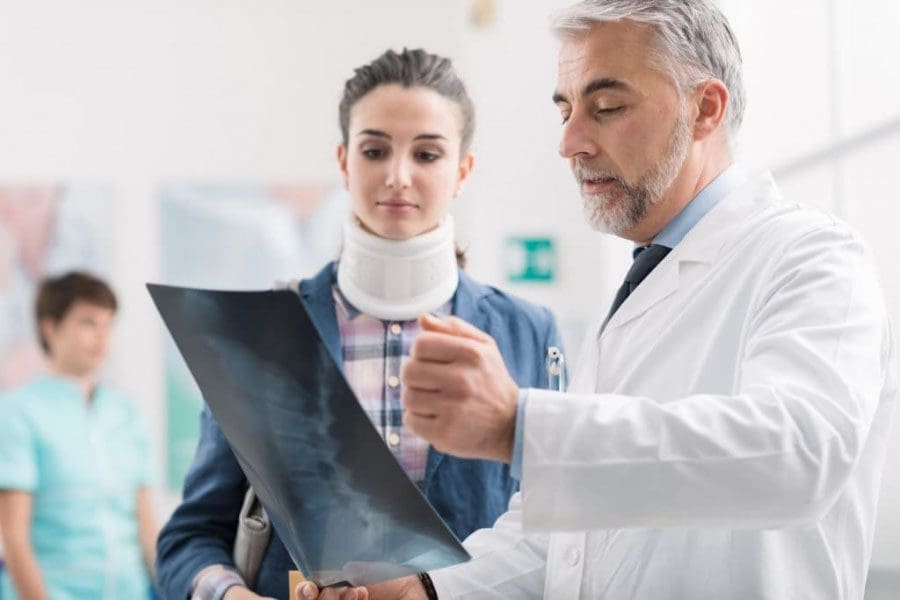 �
�However, with all the construction taking place nowadays, excavators, bulldozers, steamrollers, forklifts, and other vehicles are also seeing a rise in accidents. This is also generating a rise in spinal cord injury/s. Auto accidents are now ranked as the number one cause of spinal injury. The risk of an accident is small and the risk of a resulting serious spine injury is smaller still, it�s not anything. What you need to know about a motor vehicle accident/collision includes:
- Injuries
- Treatment
- Recovery
- Insurance
- Legal issues
Contents
Common Motor Vehicle Accidents/Collisions
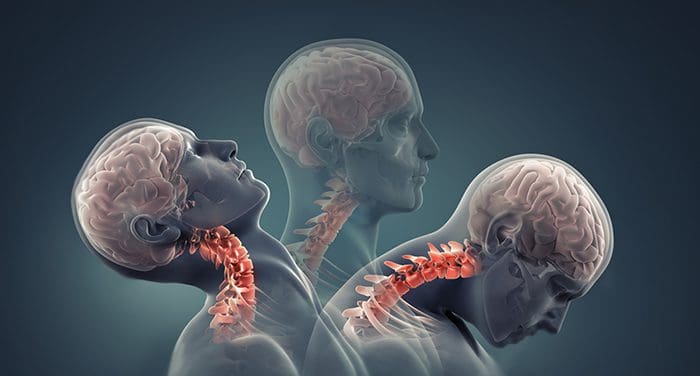
�
Whiplash
Whiplash is one of the most typical injuries following an accident, especially when rear-ended or a rear-end collision. Its a neck injury that happens when the neck snaps suddenly back and forth causing trauma to the tissues in the neck. Symptoms often develop a few days after the accident including:
- Limited neck movement
- Stiffness and pain in the neck
- Pain or tenderness in the upper back, shoulders, and arms
- Numbness or tingling in the arms
- Dizzyness
- Headaches starting at the base of the skull
- Problems with concentration or memory
- Ringing in the ears
- Sleep issues
- Depression
Herniated Disc
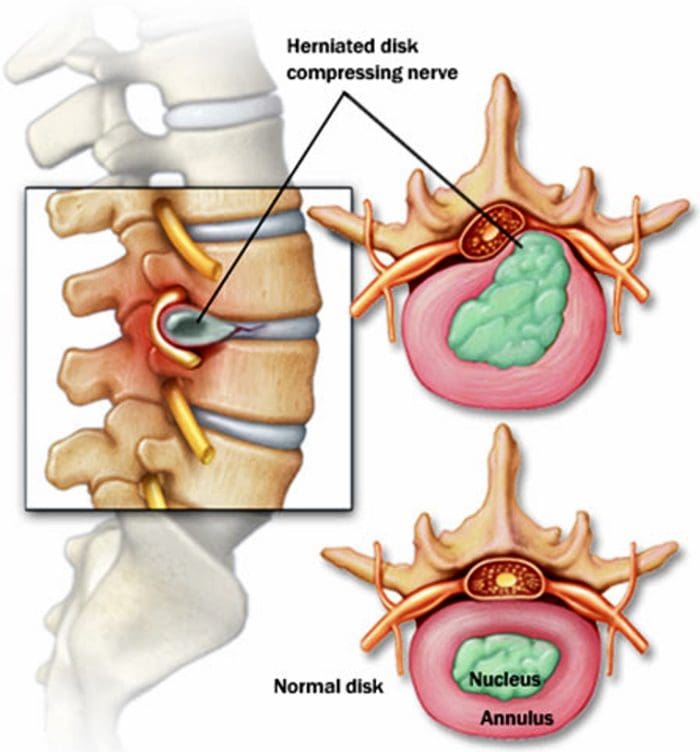
The discs in the spine cushion the vertebrae by absorbing the weight, force, and overall impact of a regular day. They are made of a soft, gel-like substance in the center that behaves like the gel in foot orthotics, shoes, mattresses, etc made to feel soft and comfortable. It has a tough outer membrane.
A herniated disc happens when that soft gel springs a leak/s out from a tear, meaning the shock-absorbing cushion has been compromised and is not delivering the absorption it’s supposed to and places added pressure on the surrounding nerve/s and roots. Herniations can happen naturally from age and from jobs that involve consistent and constant repetitive:
- Pushing
- Pulling
- Bending
- Twisting
Herniations also happen after going through some type of physical trauma like a motor vehicle accident/collision. Symptoms depend on where the herniation occurs and include:
- Muscle weakness around the affected nerve/s
- Sharp shooting pain that can spread out from the shoulders to the arms, legs and low back
- Tingling in arms or legs
- Numbness
- There could also be no symptoms and no discovery of a herniated disc until tested for something else.
�
Vertebral Fractures
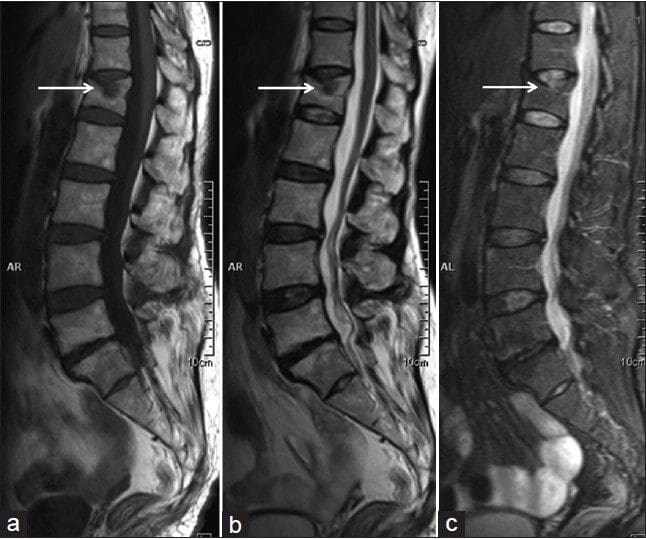
The vertebrae are highly susceptible to fractures of all types and can appear at any spot along the spine. For many, the injuries are mild and heal with non-surgical treatment and time. Major trauma to the spine can cause severe injuries/conditions which include:
Burst fractures
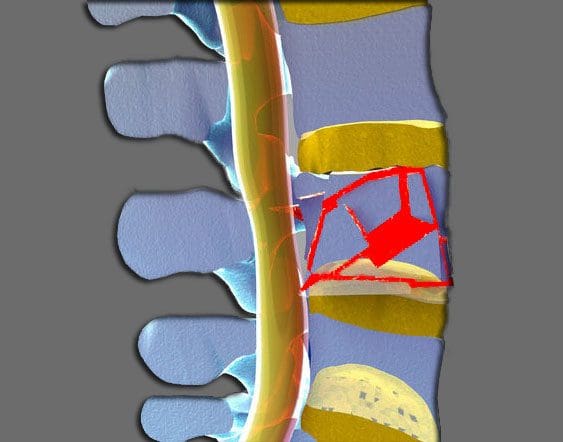
This is where the vertebra fractures in multiple places into bony fragments that fall into the spinal cord getting lodged inside with the jagged edges of the bones creating tears, cuts, etc that can result in paralysis and even death.
Flexion fracture
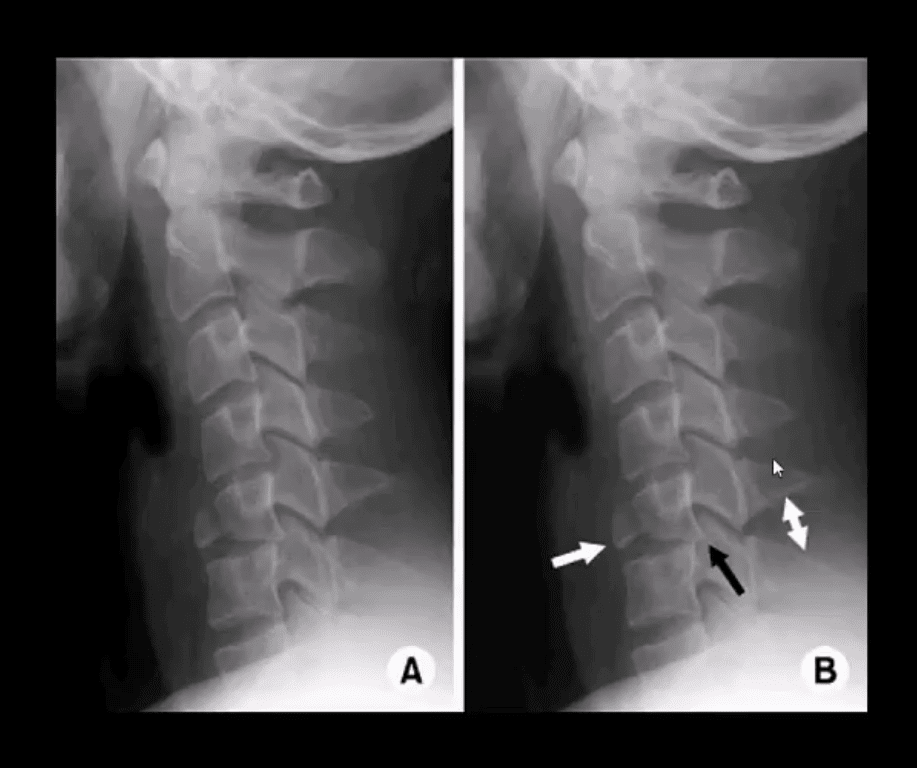
This is an injury seen in head-on collisions where the upper part of the body gets thrown forward and the bottom part stays in place likely from the seatbelt. This tears the vertebra apart resulting in a flexion teardrop fracture.
Vertebral compression
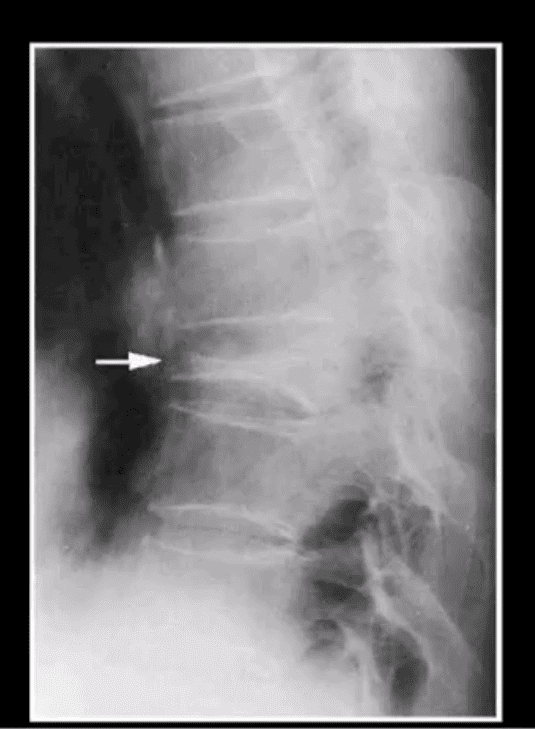
These types cause the front of the vertebra to collapse while the back keeps its position that forms a wedge-like shape. However, more often it is associated with osteoporosis, healthy individuals can experience a vertebral compression fracture from a serious traumatic event like an auto accident. Fractures can cause mild to severe pain that is exacerbated with movement. If the spinal cord is injured the individual could experience:
- Tingling
- Numbness
- Weakness in the limbs
- Loss of bladder/bowel function
Because of the increased safety features in today’s vehicles, fractures of the spine are rare except for severe motor vehicle accidents/collisions.
�
Diagnosis and treatment
A doctor will review medical history along with the accident information. Imaging tests will follow like:
- X-ray
- CT or computed tomography scan
- MRI or magnetic resonance imaging
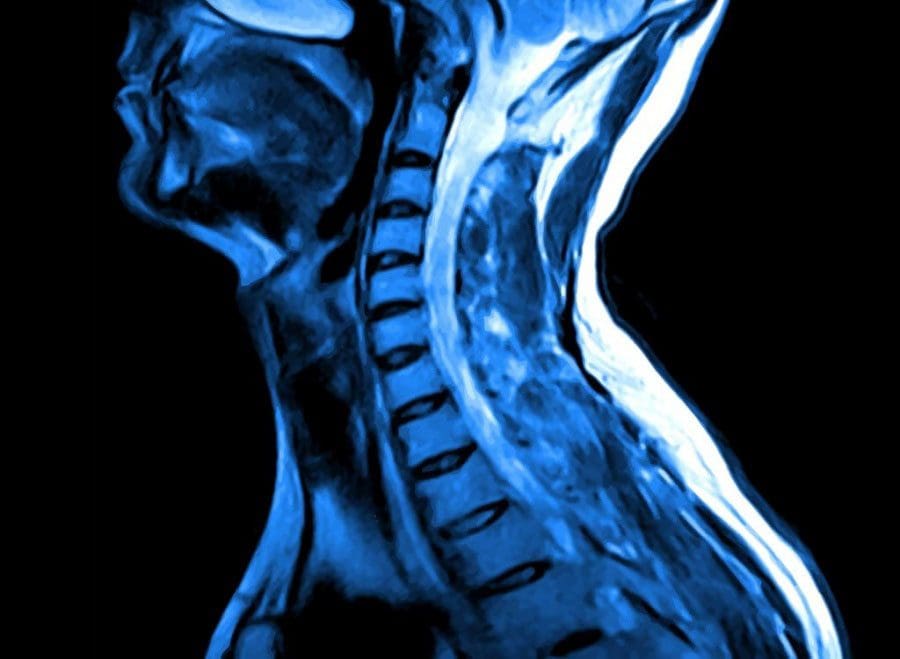
The way these techniques of imaging are done depends on the accident and the state of the spine. Being brought into the hospital from a motor vehicle accident/collision with a suspected spinal injury means the imaging will be done first to rule out or not potentially life-threatening injury/s to the spine. Treatment for spinal injuries can range from:
- Soft collar
- Chiropractic
- Over-the-counter anti-inflammatory medications
- Corticosteroid injection/s
- Nerve blocks
- Physical therapy
- Surgery to correct certain injuries when all other forms of treatment are not working
�
Recovery
Every case, accident, and injury is different�and depends on several factors, like age, health, and how severe the accident/collision was. Severe and extreme injures like a burst fracture can take a long time to heal. �
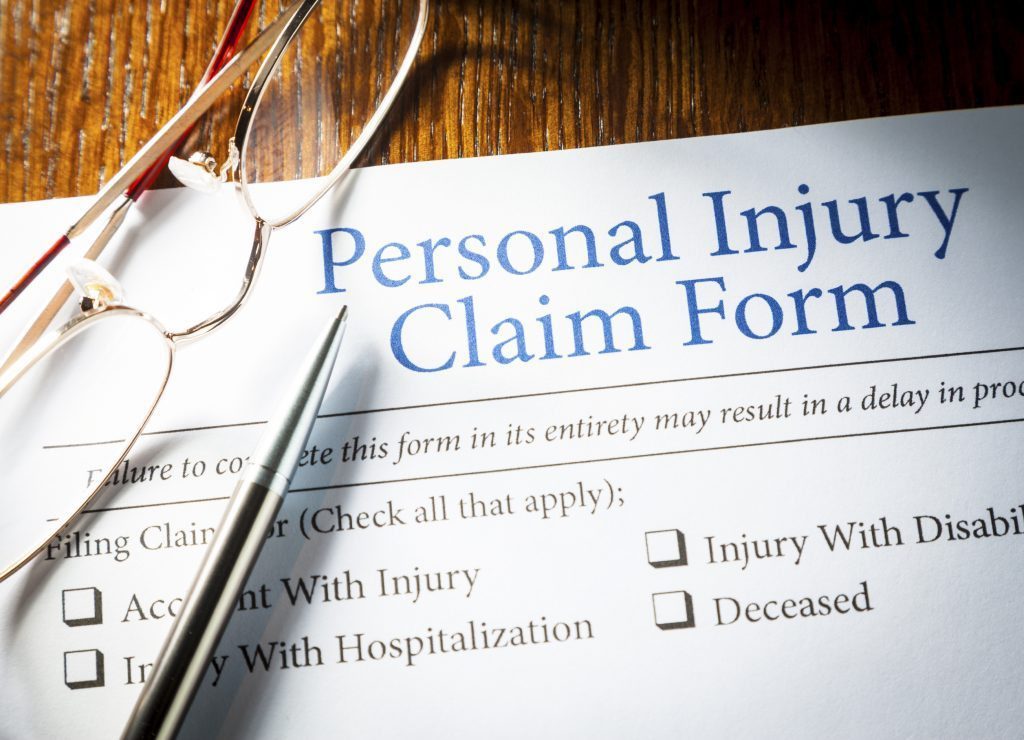
Legal Issues
Individuals with a spinal injury can face thousands in medical bills. If there is medical equipment involved along with therapeutic services for long-term care, like physical therapy then bills will accumulate.
Also, a personal injury claim could be necessary to pay for everything, especially, if the accident/collision is no fault of your own. Compensation could help with:
- Loss of employment
- Employment benefits
- Wages lost
- Ability to work/earn income
- Medical expenses
- Pain
- Suffering
- Consult with a specialist when considering filing a personal injury claim
�
Work Compensation
If a spinal injury accident happens at work there could be worker’s compensation. Workers� compensation is insurance that replaces wages and medical benefits to workers that have been injured while doing their job. These are injuries that happened during the operation of a motor vehicle, like a truck, or forklift. The worker must file an injury report immediately so there is documentation supporting the injury claim. Waiting to file can make the employer question if there even was an injury. A workers� compensation claim works differently than a personal injury claim, based primarily on what is covered under the job’s insurance policies.
An example is the legal term pain and suffering. This is not covered by workers� compensation. However, a work training accident would be covered by work comp in the event that the individual cannot return to their job/occupation after the injury. However, any injury/s after a motor vehicle accident/collision should never be taken lightly or ignored. Individuals must be proactive in their treatment after an accident/collision. This is to prevent and avoid further injury.
�
Auto Accident Doctors & Chiropractor Treatments
Dr. Alex Jimenez�s Blog Post Disclaimer
The scope of our information is limited to chiropractic, musculoskeletal, physical medicines, wellness, and sensitive health issues and/or functional medicine articles, topics, and discussions. We use functional health & wellness protocols to treat and support care for injuries or disorders of the musculoskeletal system. Our posts, topics, subjects, and insights cover clinical matters, issues, and topics that relate and support directly or indirectly our clinical scope of practice.*
Our office has made a reasonable attempt to provide supportive citations and has identified the relevant research study or studies supporting our posts. We also make copies of supporting research studies available to the board and or the public upon request. We understand that we cover matters that require an additional explanation as to how it may assist in a particular care plan or treatment protocol; therefore, to further discuss the subject matter above, please feel free to ask Dr. Alex Jimenez or contact us at 915-850-0900. The provider(s) Licensed in Texas& New Mexico*
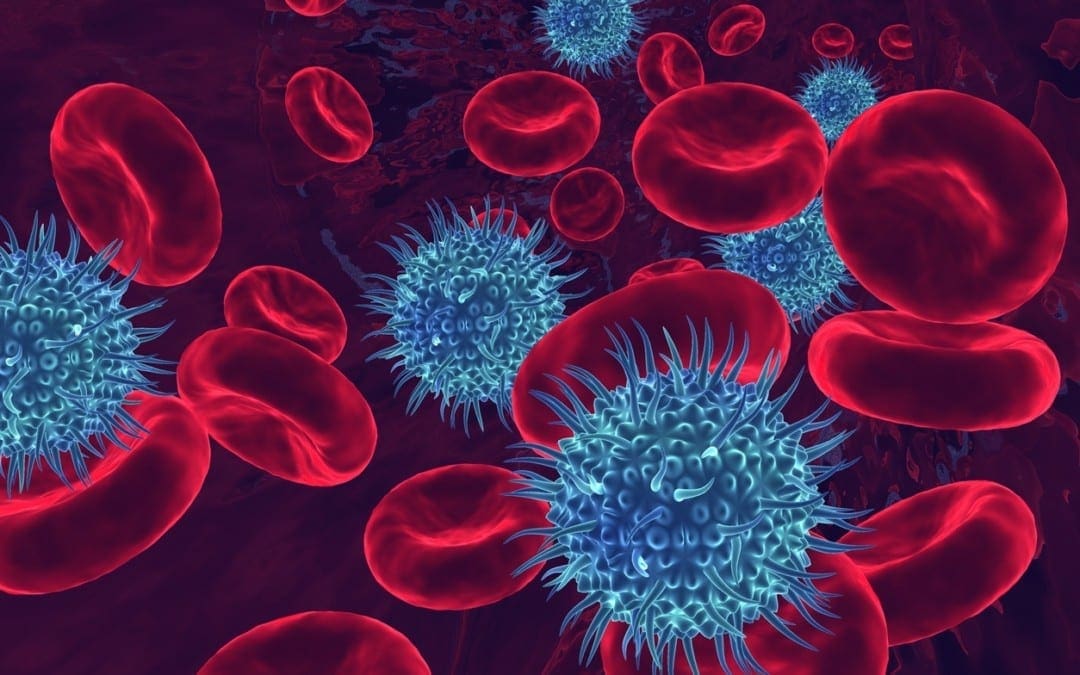
Understanding HIV/AIDS and Opportunistic Infections
Infections can happen to any individual given specific circumstances, however, infections occurring in HIV/AIDS patients are more commonly referred to opportunistic infections or OIs. HIV/AIDS severely dampens the immune system of the patient, making it less able to fight off infections. It wipes out the white blood cells that eliminate an infection. Specific types of bacteria, viruses, fungi, and other organisms, which do not commonly result in infections in individuals who are healthy can make those with weak immune system sick. This exposes them to the dangers of suffering from opportunistic infections (OIs). OIs are severe infections that affect an individual due to his or her weak immune system. The strength of an individual�s immune system with HIV can be estimated through the T cell count, which is also referred to as the CD4 count. When the T cell count is under 200�cells per microL,�it means that the individual condition has deteriorated to AIDS and, thus, he or she faces the risk of suffering from opportunistic infections. Nevertheless, a lot of opportunistic infections can be inhibited when the individual is placed on specific antibiotics and anti-fungal medications. HIV medications can also enhance the T cell count and reduce the risk of the individual suffering from opportunistic infection. This can normally be minimized when the individual is given continual therapy. Opportunistic infections are generally less widespread and less severe in healthy people.Contents
What is an Opportunistic Infection (OI)?
Opportunistic infections (OIs) are the types of infection that commonly develop in individuals with weakened immune systems than in people with healthy immune systems. Individuals with weak immune systems are mostly HIV patients and patients receiving chemotherapy treatments. OIs are normally caused by a lot of germs which include viruses, bacteria, fungi, and parasites. Germs that cause OIs can be transmitted through various ways including the air, the saliva, semen, blood, urine, poop of an infected person or through contaminated food and water. Individuals who are more at risk of suffering from OIs are those with their CD4 count below 200, but you can contract some OIs when your CD4 count is less than 500. OIs are not as widespread now the way they were when HIV and AIDS first originated, due to the fact that a better treatment is now available which minimizes the quantity of HIV in an individual�s body and this increases the immune system. Nevertheless, a number of people with HIV still develop OIs due to the fact that they were unaware that they were infected with the HIV virus for a good number of years after their infection. Individuals who know that they have HIV, but who are not receiving the antiretroviral treatment (ART), will still be infected by OIs. Individuals who have AIDS, but who are not taking medication for the prevention of OIs, can also suffer from OIs. The best way to stay clear of opportunistic infections is to stay in care and get your�lab tests�carried out. This will help your doctor and other medical teams know when you may be facing the risk of OIs and ensure that they are prevented. Most opportunistic infections can be prevented by taking additional medications. There are different types of OIs. This includes the following amongst others:- Bacterial infections like�tuberculosis�and similar disease,�Mycobacterium avium complex�(MAC)
- Viral infections like�cytomegalovirus�(CMV) and�hepatitis C
- Fungal infections such as yeast infections, cryptococcal meningitis,�pneumocystis carinii pneumonia(PCP) and�histoplasmosis
- Parasitic infections like crypto (cryptosporidiosis) and toxo (toxoplasmosis)
- Having HIV/AIDS and complications from common illnesses like flu.
- Salmonella�infection
- Herpes simplex virus 1 (HSV-1) infection. This is a viral infection that can result in a sore mouth and face
- Salmonella�infection a bacterial infection that affects the gut.
- Candidiasis (or thrush). This is a fungal infection of the mouth, esophagus, or vagina
- Toxoplasmosis (TB). This is a parasitic infection that can have a harmful effect on the brain.
Why Do HIV/AIDS Patients Get OIs?
As soon as an individual is infected with HIV, the virus starts to multiply and begins to injure the individual�s immune system and immune function. A weak immune system makes it difficult for an individual�s body to ward off HIV-related OIs. HIV medication inhibits the capacity of HIV to cause damage to the immune system. However, if the individual does not take the medication, HIV will gradually be destroyed by the immune system. Most OIs, for instance, the ones that contain specific forms of pneumonia and tuberculosis (TB), are taken as AIDS-defining conditions. AIDS-defining conditions are infections and cancers that are life-threatening in individuals suffering from HIV.Prevalence of OIs in People with HIV/AIDS
OIs were formally the leading cause of death among individuals with HIV before the advent of medications used in the treatment of HIV infection. Now that HIV medicines are very widespread in the US, the occurrence of OIs among aids patients has been reduced. HIV medications reduce the ability of HIV to damage the immune system and by so doing, it impedes the occurrence of OIs.Prevention of Opportunistic Infections
The best ways to prevent yourself from becoming infected with an OI are to start medical care and to take HIV medications according to the doctor�s prescription. Sometimes, your doctor will also recommend drugs specifically for the prevention of specific types of OIs. When you take your HIV drug, you can reduce the amount of HIV in your body and this would, in turn, increase your immune health and prevent you from being infected by OIs. It is particularly significant that you go through standard check-ups. While you go, remember to go with all your medications and take the drugs according to the recommended dosage and time. You may have to take HIV medications for the length of your life. Other things you can also do to improve your immune function and minimize opportunistic infections include the following:- Use condoms every time you have sex and in the correct manner to limit your exposure to sexually transmitted infections.
- Don�t share tools for drug injection with anyone. Blood infected with hepatitis C can stay in syringes and needles after they are used and the infection can be transferred from one user to another user.
- You need to get vaccinated with a suitable vaccine. Your medical teams will advise you on the best vaccine to take.
- Limit your contact with germs that cause OIs. For instance, germs that cause tuberculosis are found in the poops, saliva, or on the skin of animals.
- Be cautious with things you eat and drink. Avoid eating undercooked eggs, unpasteurized (raw) milk and cheeses, unpasteurized fruit juices, or raw seed sprouts. Avoid drinking water that is not treated, like water from lakes or rivers. Depending on your country, tap water is also not safe for drinking. Make use of bottled water or water filters.
- If you are visiting abroad ensure that the food and water you eat and drink will not make you sick.
- Find out from your doctor other safety precautions you need to take at work, at home, and while on a holiday trip to ensure you stay safe.
Treatment of Opportunistic Infections
There are various medications to treat HIV-related OIs. These include antiviral,�antibiotic, and�anti-fungal�medication. The type of drug you will need to take depends on the particular OI. As soon as the OI is effectively treated, an individual may continue to use the same medication or extra medication to inhibit the reoccurrence of OIs. An OI can be a severe medical condition that may be difficult to treat. The development of an OI possibly implies you have a weak immune system and that you are not putting your HIV properly in check. This is why it is essential to take your medication according to the prescription and book appointments with your doctor for routine checks to minimize the spread of the virus. This also ensures that you keep your immune system healthy.Understanding Common Opportunistic Infections
HIV and Rheumatic Disease
Rheumatic diseases that are linked with HIV affect individuals of all age groups. However, they are more common among individuals between twenty to forty years of age. An individual may contract HIV-related rheumatic diseases before being infected with HIV. The signs and symptoms of rheumatic diseases, their treatment, and HIV infection can all have common characteristics. The majority of people with HIV-related rheumatic diseases get better after several HIV treatments. Several older medications for HIV and AIDS can cause joint and soft tissue ache and muscle weakness. Others are associated with metabolic bone disease. Many people with HIV experience musculoskeletal issues with pain affecting the joints, muscles, and bones. HIV infection can result in rheumatic (joint and muscle) which can include joint pain, arthritis, muscle pain, weak spot, and exhaustion. However, it is not every muscle, bone, and joint complaint experienced by people who have HIV come from HIV. Some of them occur due to other reasons. It can also come with supplementary articular symptoms, like uveitis or eye inflammation, which may also exist in individuals with HIV who are suffering from arthritis. Occasionally, the individual starts to experience these symptoms before observing the HIV signs. HIV-associated rheumatic diseases are diseases of the joints and muscles that affect an individual with HIV infection. It can result in aching and inflammation. Pain in the joints, soft tissues, adjoining joints, and muscles are frequently the foremost symptoms experienced by 5% of HIV positive patients. Less widespread rheumatic diseases that can be experienced by individuals suffering from HIV are:- Infection of the joints also known as septic arthritis, muscles infections known as myositis and infection of the bones known as osteomyelitis.
- Psoriatic arthritis
- Reactive arthritis
- Polymyositis or irritation of muscles
- Fibromyalgia
- Vasculitis or swelling of blood vessels
Causes of HIV-Associated Rheumatic Diseases
HIV-related rheumatic illnesses can be experienced by both males and females, irrespective of their ages and their ethnic background. Widespread risk factors of HIV infection include unprotected sex and the administration of IV intravenous medication with shared needles. There are many reasons why individuals with HIV experience rheumatic disease. The infection can be due to direct cause, while some can also be caused by other viruses or bacteria.Diagnosis and Treatment of HIV-Related Rheumatic Diseases
HIV-related rheumatic diseases can be treated with the use of antiretroviral drugs. The combination antiretroviral therapy (cART) use started in the mid-1990s. cART is frequently referred to as the �cocktail� of HIV medications due to the fact that it is the unification of up to three HIV medications. This treatment has tremendously increased the symptoms of HIV, in addition to the ones that affect the joints and the muscles. the cART has minimized the number of HIV patients that suffer from a rheumatic disease. And when they do get one, it is much easier to treat. The majorities of HIV patients respond very well to regular treatments. This is a combination of pain relief medications and anti-inflammatory medicines given to reduce inflammation, aching, and fever. Individuals who respond poorly are prescribed medications that repress their immune system. They may also require physical therapy to alleviate symptoms, avoid deforming their joints, and improve their function.How to Prevent HIV-Related Rheumatic Diseases
Most factors that increase your risk of suffering from HIV also increase your risk for HIV-related rheumatic disease. To minimize your risk of suffering from the two diseases, you should engage in safe sexual practices. If you are HIV infected, you need to take your medication as the doctor prescribed. Again, the Centers for Disease Control and Prevention recommend that individuals with HIV go for HIV routine screening in all healthcare settings for individuals between the age of thirteen and sixty-four years old. Specific groups ought to be more concentrated upon such as seniors with an active sex life together, pregnant women that are mostly less than 24 years, and men who engage in sexual activities with fellow men.How to Manage HIV & Rheumatic Diseases
Individuals with HIV who have money to pay for cART and whose body can tolerate them commonly live longer. Nevertheless, HIV-related rheumatic disease can result in uneasiness, weakness of the muscle, and impaired function. To stay healthy as an HIV patient apart from taking your medication as prescribed, you must also eat a balanced diet and engage in proper exercise. If you experience weak joints or pain or weakness of the muscles while you take HIV drugs, take the medication to your doctor, and have a thorough review of the medications you are taking. Find out if any of the symptoms you are experiencing is a result of the medication you are taking.Toxoplasmosis in HIV-Infected Patients
Toxoplasmosis is an infection that is experienced by people all over the world. It is usually caused by a Toxoplasma parasite that infests the individual without resulting in any serious symptoms. Nevertheless, the parasite sticks with the individual�s body and can result in a severe brain infection among people suffering from HIV/AIDS. Individuals that are diagnosed with HIV are usually recommended to go for a blood test to check if they have been infected by the Toxoplasma parasite before that time. Toxoplasmosis is the most widespread central nervous system infection experienced by people diagnosed with the acquired immunodeficiency syndrome (AIDS), especially those of them that are not being given suitable prophylaxis. The Toxoplasmosis infection is spread all over the globe and transmitted by the intracellular protozoan parasite known as�Toxoplasma gondii. Individuals with a healthy immune system that are suffering from standard toxoplasmosis are normally asymptomatic and dormant infection can stick with the individual all through his or her life. However, in individuals with a weak immune system, particularly people suffering from AIDS, the parasite can become activated again and result in disease, especially when his or her CD4 count measures lower than 100�cells per microL.Epidemiology
If the T count of a patient with AIDS is below 100�cells per microL, the individual is recommended to take preventive treatment. There are some antibiotics used to prevent PCP. These antibiotics can also be used to prevent Toxoplasma. The likelihood of reactivated toxoplasmosis emerging among AIDS patients who have a CD4 count less than 100�cells per microL, who are toxoplasma seropositive and are not being given efficient prophylaxis or antiretroviral therapy is as large as 30%. This reactivation normally takes place in the central nervous system (CNS).�Transmission
Human beings normally get the infection by eating infectious oocysts, normally from soil or cat litter infected with catlike poops, or non-properly cooked meat from an animal that is infected. If an individual swallows�T. gondii oocysts, the parasite raids the intestinal epithelium and circulate all through the body. Afterward, they encyst into any form of composite cell and remain inactive inside the tissues of the individual all through the person�s life.How Common is the Infection?
The spread of the infection caused by�T. gondii differs greatly across different countries of the world and the range differs roughly by 11% in the United States to over 80% in some European, Latin American, and African nations. Generally, the seroprevalence of antibodies to�T. gondii�amongst HIV-infected individuals is similar to the rate of seropositivity in the general population and is not related to possessing a cat. Nevertheless, the prevalence may be associated with age. For instance, a research study with HIV-infected women in the United States found that individuals 50 years old or younger are probably going to be more seropositive compared to younger women.Blood Test and Prevention
If the result of the blood test indicates that the individual has not previously contracted the toxoplasmosis infection, it is very essential for the individual to stay away from such environment that would expose him or her to the infection.Causes and Sources
The widespread sources of the parasite are raw or uncommon meats like lamb, beef, pork, or venison meats; cat stool, and soil.Prevention
The preventive methods an individual infected with HIV, who have not been exposed to Toxoplasma in the past, include the following:- Avoid eating raw or uncommon lamb, beef, pork, or venison. Meat that is pink in color shows that it is not properly cooked. The interior temperature of the meat must be up to 165�F and above.
- Do not change your cats litter by yourself. If no one is around to assist you, make use of hand gloves and wash your hands properly afterward to ensure that they don�t touch your hands. Also, try to avoid touching wandering cats.
- Wash hands after farming.
- Always wash your hands and cooking worktops after preparing raw meat or poultry.
- Always wash your fruits and vegetables thoroughly if you want to eat them raw.
HIV and Hepatitis B
Hepatitis B is a liver disease that is caused by a virus known as Hepatitis B virus (HBV). When an individual is infected with both HIV and HBV, it is referred to as HIV/HBV coinfection. Individuals with HIV/HBV coinfection ought to be treated for the two-health condition. The abbreviation HBV can be used to represent the virus or the disease itself. HBV can either be a quick-fix or acute condition or a long-term illness which can be chronic.- Acute HBV condition can exist for less than six months after an individual is exposed to HBV. Acute HBV can deteriorate to chronic HBV, although this is not always the case.
- Chronic HBV is a lifelong disease. Without treatment, chronic HBV can cause liver cancer or liver damage that leads to liver failure. HBV is a contagious disease that can spread from person to person.
Transmission of HBV
HBV is transmitted through contact with the blood, semen, or other body fluid of an individual who has HBV. In the US, HBV is most commonly dispersed through sexual activities. HBV can also be dispersed through the following methods:- By using the needle or other tools used for drug injection which has been used for an individual with HBV
- By using razors, toothbrushes, or related materials that has been used by an infected person.
- From an unintended puncture or cut from an HBV-infected needle or other pointed materials
- Congenitally through a mother to her baby during childbirth
Connection Between HIV and HBV
HIV and HBV both can be dispersed through the following ways: semen, blood, or other body fluids of an infected person. Thus, the key risk factors for HIV and HBV are equivalent: having unprotected sex and medical treatments that involve the use injection medicines. It was found by the�Center for Disease Control and Prevention (CDC) that roughly 10% of individuals with HIV in the United States also suffer from HBV. Infection with both HIV and HBV is known as HIV/HBV coinfection. Chronic HBV worsens faster and easily deteriorates to cirrhosis, which is the final stage of liver disease and liver cancer in individuals suffering from a combination of HIV and HBV coinfection. However, chronic HBV doesn�t seem to cause HIV to increase faster in individuals with HIV/HBV coinfection.Prevention of HBV Infection
The best prevention method for HBV infection is through the�hepatitis B vaccine. CDC recommends that individuals with HIV, and those at risk for HIV, get the HBV vaccine or the combination of the two hepatitis A virus [HAV]/HBV vaccine. The housemates and sexual partners of individuals living with HBV need to also be vaccinated. HIV patients can also prevent infection from HBV through the following:- Make use of condoms during sex to lesson HBV infection risk and risk with other sexually transmitted diseases like�gonorrhea�and�syphilis.
- Avoid using injections. However, if you must, avoid sharing needles, syringes, or other tools use in injecting medications.
- Don�t share toothbrushes, razors, or other personal materials that may be infected by the blood of the person suffering from HB.
- If you are getting a tattoo or body piercing, ensure the instruments you are using are sterile.
Why People with HIV Must be Tested for HBV
All people infected with HIV ought to be tested for HBV. Testing for HIV can discover HBV infection even when an individual has no symptoms of the disease. There are many forms of blood tests that can be conducted for HBV. The outcome of the different tests has a different significance. For instance, a positive hepatitis B surface antigen (HBsAg) test outcome is used to indicate that an individual has acute or chronic HBV and can transfer the virus to others.Why HBV Therapy is Essential for HBV/HIV Coinfected Patients
- Liver disease may deteriorate faster in individuals co-infected with HBV/HIV and could result in severe liver disease impediments like cirrhosis and liver cancer at early ages.
- Once HIV patients co-infected with HBV start to take antiretroviral therapy their risk of developing hepatotoxicity is increased more than in individuals who only have HIV alone.
- Hepatitis B in HIV-infected patients has a close link with a lower CD4 T-cell count than HIV-monoinfected individuals.
Symptoms of HBV Infection
Many people with acute HBV don�t experience symptoms of infection. A number of people can exhibit symptoms of HBV immediately after they have been infected. Mild to serious symptoms of acute HBV are listed below:- Appetite loss
- Weariness
- Nausea
- Fever
- Stomach ache
- Dark urine
- Clay-colored poop
- Joint and tummy pain
- Jaundice or yellow color of the skin and whitening of the eyes.
Treatment for HBV
Commonly, HBV is treated with antiviral drugs. The medication helps to slow down or inhibit HBV from injuring the liver. People with HIV/HBV coinfection ought to be treated for the two infections. A number of HIV medications are effective for the treatment of both HIV�and�HBV. The choices of medications to treat HIV/HBV coinfection vary depending on the individual. For instance, a number of people may take just medications that are also efficient against HBV. Other individuals may take HIV drugs and an HBV antiviral medicine. If you have HIV/HBV coinfection, speak with your health care provider to discover which medication is the best for you.HIV and Hepatitis C Infection
Hepatitis C is a liver disease caused by the hepatitis C virus (HCV). HCV is a communicable disease that can be transferred from one individual and another. HCV is mainly dispersed from one individual to the other through contact with infected blood. The majority of people with HCV get the infection by sharing needles or other tools for injecting drugs. The abbreviation HCV can be used for representing the virus or the disease that results from it. HCV can be acute type which lasts short-term or a long-term or chronic illness:- Acute HCV manifests within six months after an individual contracts HCV. In most people, acute HCV becomes chronic HCV.
- Chronic HCV can last for a long time. If the individual does not receive treatment, the chronic HCV can result to liver cancer or serious liver damage that can result to liver failure.
Mode of Transmission
HCV can be transferred from one individual to the other, mainly through blood contact of an individual who is infected with HCV. In the United States, HCV is mostly dispersed by sharing needles or other injection drug equipment with an individual who has been infected by HCV.Connection Between HIV and HCV
HIV and HCV infection can both be dispersed through the blood. Two of them also have as their risk factor the use of injection drugs. Sharing needles or other drug-injection equipment increase the risk of contracting HIV or HCV from any blood that has been previously infected. The Centers for Disease Control and Prevention (CDC) data specified that roughly 25% of individuals with HIV in the United States also suffer from HCV. It also states that roughly 50 � 90% of individuals who make use of injections suffer from HCV. When an individual is infected with both conditions, it is referred to as HIV/HCV coinfection. In individuals with HIV/HCV coinfection, HIV may make severe HCV to progress quicker. It is not yet known if HCV increases the worsening effects of HIV.Prevention of HCV
The most appropriate way to protect an individual against HCV is not through drug injections. If you are injecting drugs, it is better to make use of fresh and sterile needles. Avoid making use of needles previously used or sharing needles, syringes, or other equipment for injecting drugs. Other things individuals with HIV can do to protect themself from HCV infection are:- Avoid sharing toothbrushes, razors, or other personal items that may be infected by the blood of a sufferer.
- If you have a tattoo or body piercing, ensure the instruments used are germ-free.
- During sex, make use of condoms. Although it can be contacted through sexual contacts, the risk of HCV through this form is usually minimal. However, the risk increases if an individual is HIV positive.
- Condoms also minimize the risk of�HIV transmission�and infection with other sexually transmitted diseases like�gonorrhea and�syphilis.
People with HIV and Test for HCV
All individuals with HIV need to undergo tests for HCV. Normally, an individual goes through an HCV antibody test as the first line of treatment. This test is carried out to examine if the antibodies of HCV are present in the blood. HCV antibodies are disease-fighting proteins that the body produces in response to HCV infection. If an individual shows a positive result on an HCV antibody test, it implies that the individual has been uncovered to HCV at a point in their life. When the result of the test reads positive, it must be confirmed by a second test. The second test is carried out to verify if HCV is present in the blood of the individual. If the result is positive, it means the individual is suffering from HCV.Symptoms of HCV infection
Many people who have acute HCV don�t experience symptoms. But a number of people can have signs of HCV shortly after becoming infected. Gentle to a more serious symptom of acute HCV can include the following:- Fever
- Exhaustion
- Loss of appetite
- Feeling sick
- Vomiting
- Stomach ache
- Dark-colored urine
- Clay-colored bowel movements
- Joint pain
- Jaundice or yellowish skin or whitening of the eyes
Treatment for HCV
HCV is treated with antiviral medications. The drug is very effective for slowing down or stopping HCV from injuring the liver. A number of recent medications for the treatment of hepatitis C are more efficient. They come with fewer side effects than older medications. The newer HCV medicines may get rid of HCV from the body of the individual entirely. Individuals with HIV and HCV coinfection are treated for the infections concurrently. The commencement of the treatment and the medication to use depend on the individual. This is essential because a number of HIV and HCV medications may affect the health if used together. It is better to speak with your doctor for advice if you have HIV/HCV coinfection. Taking HIV and HCV drugs concurrently may increase the risk of drug-drug interactions and side effects. Health care providers recommend HIV and HCV medicines cautiously to avoid�drug-drug interactions�and strongly monitor those receiving the medications for any side effects.�
Histoplasmosis
Histoplasmosis is a disease caused by a fungus or mold known as Histoplasma. The infection is transmitted to an individual when he or she breathes the fungal spores. It cannot be transferred from an individual to individual through physical contact. The fungus usually grows in soil and places that are contaminated with bat or bird droppings. It is frequently seen in places like Mississippi, Ohio, and St. Lawrence River valleys, the Caribbean, southern Mexico, and some parts of Central and South America, Africa, and Asia. It can result in pneumonia in individuals who are diagnosed with HIV, especially those with a low T cell count, and who resides in places with a high risk of infection. Individuals who are visiting or living in these places must avoid engaging in activities that place them on a high risk of suffering from the condition like digging up of soil under bird roosting sites, knocking down of old buildings or investigating caves. An anti-fungal treatment may be prescribed for individuals that have a low T cell count usually less than 150�cells per microL�who are at high risk of being infected; this includes individual living in the locations where the infections are frequently found. Histoplasmosis is not commonly serious and doesn�t come with symptoms. If you ever get sick, it normally affects your lungs. Symptoms of Histoplasmosis are nausea, feverishness, chest aches, and a dry cough. In serious instances, histoplasmosis can disperse to other organs of the body. When this happens, it is referred to as disseminated disease. This frequently occurs in newborns, young children, seniors, and individuals who have problems with their immune system and immune function. Your doctor may conduct a lot of tests to make the diagnosis. These are chest x-rays, CT scan of the lungs, or examination of blood, urine, or tissues for symptoms of the fungus. Mild instances of the infection are usually reduced after sometimes without any form of treatment. However, chronic or more serious cases are managed with the use of anti-fungal medications.Test and Diagnoses
Fungal tests are normally used to diagnose a fungal infection for proper guidance on the treatment of the condition and to examine how effective the medications used are. A number of less serious skin and yeast infections would require a clinical examination of the body parts that are affected. This can suitably be carried out through a microscopic examination of the sample. It is sufficient to discover the presence of fungus and not a specific type of fungus. The medical team can make use of a number of topical and oral anti-fungal drugs and medications.- To get persistent, deeper, or�systemic�infections, a lot of tests may be carried out. To discover the type of fungus that is present, fungal cultures are normally utilized.
- Most fungi grow slowly. Tests, thus, usually take weeks to produce results. Susceptibility testing�is normally carried out on fungi isolated from a culture. This can be used to determine the anti-fungal drug, which can work best from the treatment of the condition.
- Tests for fungal�antigens and�antibodies�may be prescribed to check if an individual has, or recently had, a particular type of fungal infection. They are faster than fungal cultures. However, they are used to test for particular species of specific fungus. Therefore, your medical team must be aware of the type of fungus to test for.
- Most people who have the infection also suffered from fungal antibodies in the past from a previous exposure to the organism, thus one antibody test may not be sufficient to verify if the infection is present in the present situation. Often times, blood samples are taken two to three weeks difference for acute�and�convalescent results. The test is usually conducted to show if antibody levels (titers) are altering. The evaluation of these results may take quite a few weeks.
- Molecular tests can also be used to determine the fungi that have grown in culture. It can occasionally be used to discover particular fungus present in the sample immediately.
Who is at Risk for Histoplasmosis?
Histoplasmosis can be contracted by any individual who lives in a high-risk zone or an area where Histoplasma�lives in the environment. Histoplasmosis is frequently connected with activities that upset soil, especially soil that is made up of bird or bat droppings. Specific groups of individuals face a greater risk of developing more serious types of Histoplasma. This includes individuals with weak immune systems like people who:- Have HIV/AIDS
- Did organ transplanting
- Are on medications like corticosteroids or TNF-inhibitors
- Are Infant
- Are Seniors 55 years old and more
Prevention of Histoplasmosis
Because the disease is transferred through inhalation of the causative organism, it is very difficult for the individual to avoid contracting the disease if one is living in locations that are highly exposed to these factors. If you are living in areas that have a greater risk to the infection, you must try to avoid engaging in activities that are linked with the spread of the condition like cleaning chicken coops and similar activities. You should get professional cleaners who specialize in the removal of dangerous waste to help you clean huge amounts of bird or bat droppings.Treatment for Histoplasmosis
Most infected people would require anti-fungal treatment for histoplasmosis. Your doctor may conduct a lot of tests to make the diagnosis. These are chest x-ray, CT scan of the lungs, or examination of blood, urine, or tissues for symptoms of the fungus. Mild instances of the infection are usually reduced, sometimes without any form of treatment. However, chronic or more serious cases are managed with the use of anti-fungal medications.Cytomegalovirus (CMV)
Cytomegalovirus (CMV) is a widespread virus that infects a lot of people no matter their age. Roughly one in three children in the US are already infected with CMV before they are five years old. More than half of the adults who are forty years old have already contracted CMV infection. As soon as CMV is found on the body of an individual, it stays there all throughout their life and can reactivate it. An individual can also be re-infected with another type of virus or strain. Commonly, a number of adults with CMV are usually diagnosed by the time they get to forty years of age. Cytomegalovirus (CMV) is a virus that mostly infects people all over the world. CMV can result in a calm illness with fever and body aches, but sometimes, those infected may not experience any symptom. CMV can stay in the body of AIDS patient and cause sickness in the eyes, digestive system, brain, and spinal cord. The most widespread CMV infection is eye or retina infection. It can create a blurring effect and lead to increasing loss of vision in patients with AIDS. If the blood test of a person with HIV has a sign of previous infection, you need to do a routine eye examination of your retina if your T cell counts are less than 250�cells per microL,�whether or not they have any eye symptoms. CMV, apart from causing problems for people with weak immune systems, can also cause problems for a child in the womb if the mother is infected with the virus when she is pregnant. The majority of people infected by the viral condition do not have any visible signs. This is due to the fact that the healthy immune system normally prevents the carrier of the virus from making him or her sick. Nevertheless, CMV infection can result in severe health issues in individuals who have weakened immune systems. It also severely affects kids infected while they were in the womb.Signs and Symptoms
Many people who are infected with CMV have no symptoms and aren�t aware that they have been infected. In some instances, healthy people who are infected may suffer from mild illness which can include:- Fever
- Painful throat
- Exhaustion
- Inflamed glands.
- Swollen lymph�nodes
- Headache
- Exhaustion
- Lethargy
- Muscle pains
- Appetite loss
- Jaundice or yellow skin color
- Low birth weight
- Seizures
- Inflamed spleen
- Inflamed liver
- Pneumonia, pneumonitis or the swelling of the respiratory tract
- Blindness
- Swelling of the respiratory tract
- Diarrhea
- Esophagus�or intestines bleeding�ulcers
- Seizures
Transmission and Prevention
The body fluids of individuals with CMV may contain CMV virus. It can be found in their body fluids like urine, saliva, blood, tears, semen, and breast milk. You can get CMV from an individual who is infected through the following manners:- Through direct contact with the urine or saliva of the infected individual, especially when it is from babies and young children
- Through sexual contact
- Through the breast milk
- From organs infected by the virus. It can also be contacted through infected blood during blood transfusions
- It can be transferred from mother to child during pregnancy (congenital CMV)
Diagnosis of CMV
CMV infections are normally diagnosed via blood testsHow CMV is Treated
Healthy individuals who caught CMV infections normally do not need any medical treatment. Medications can treat CMV infection in individuals with weak immune systems and in infants with�congenital CMV infection. Regular antibiotics cannot treat CMV. It is usually managed with antiviral drugs. Antiviral drugs slow down the virus activities but do not cure it. Treatment to prevent infection with CMV is not generally recommended as it doesn�t help survival. Nevertheless, an individual with early symptoms of CMV retinitis like blurry vision, blind spots, flashing lights, or floaters must contact their healthcare provider as soon as possible because this treatment is efficient if treated as soon as they manifest.What Causes Cytomegalovirus?
The virus that causes cytomegalovirus is related to the viruses that cause chickenpox and mononucleosis. The germs find their way into body fluids, like saliva, blood, urine, semen, and breast milk. An individual can transfer the virus to others when it is active in his or her system. It is normally transmitted from one person to the other through sexual contact or contact with the blood and other fluids in the body. CMV can seldom be transferred through the processes of blood transfusion or organ transplantation. An infection of CMV in a pregnant woman can cause a miscarriage, giving birth to a dead child or death of the newborn. Newborns who survive are at an increased risk for hearing loss and mental disability. However, only a small percentage of newborns infected with CMV during pregnancy experience problems from the virus. Most are born healthy or with only mild CMV symptoms. If you are pregnant and your baby has CMV, your doctor will likely check your baby for any health problems once he or she is born so they can be treated early. Treatable symptoms in newborns include pneumonia, hearing loss, and�inflammation�of the eye.Mycobacterium Avium Complex (MAC)
Mycobacterium Avium Complex (MAC) is a severe sickness caused by common bacteria. MAC is also referred to as MAI (Mycobacterium Avium Intracellulare). MAC infection can be situated only on a single part of your body or scattered all over the body during, which it is occasionally referred to as DMAC. MAC infection frequently happens in the lungs, intestines, bone marrow, liver, and spleen. The bacteria that cause MAC are extremely widespread. They are located in water, soil, dust, and food. It is roughly prevalent in the body of every individual. The body of an individual with a healthy immune system will fight against MAC. However, individuals who have a weak immune system can easily suffer from MAC disease. Roughly half of the individuals who have AIDS are likely to suffer from MAC, particularly if their�CD4 cell count�is not up to 50 per microL. MAC nearly never results in sickness in individuals with over 100 CD4 cells. Mycobacterium avium complex (MAC) can make the individual start to experience high fevers, abdominal pain, and weight loss. Mycobacterium avium can be found all through the environment; you can hardly protect yourself from being infected by taking personal protective measures. Nevertheless, an antibiotic can be given to the individual to help prevent infection from the virus. HIV patients with the T cell count less than 50 cells per microL are commonly recommended to take the antibiotics. They�d continue the treatment until their T cell count goes higher than 100 cells per microL within a span of at least three months. Mycobacterium avium�complex (MAC) infection can be caused by one of two nontuberculous mycobacterial species which can be�M. aviumor�M. intracellulare. These organisms can infect individuals suffering from HIV infection or an individual who is not HIV positive. The two major forms of MAC infection in individuals with HIV are disseminated disease and focal lymphadenitis. As opposed to these rare pulmonary infection is commonly witnessed in immune-competent patients. Among people infected with HIV, MAC infection is most commonly witnessed in individuals with a CD4 count less than 50 cells per microL. It was found that there is a remarkable reduction in the number of new cases of MAC infection due to the treatment with the use of prophylaxis to treat MAC infection than when the epidemic originally appeared. This is even additionally reduced with the introduction of efficient antiretroviral therapy and broad use. Dramatic declines in the rate of new MAC cases accompanied the use of prophylaxis against MAC infection early in the epidemic and more recently, the widespread use of effective antiretroviral therapy.How MAC is Transmitted
The method of infection for�Mycobacterium avium�complex (MAC) is through breathing or ingestion. MAC causative organisms are everywhere in the environment. They can also be found in the water and soil. There is no requirement for individuals hospitalized with MAC infection to be isolated given that individual-to-individual or common source spread of the disease is uncommon. In one study that involves 32 individuals with AIDS and MAC from a daycare center in France that lasted for more than a thirteen-month period, the strains of organisms were varied by pulsed-field gel electrophoresis. The second series of 130 isolates from children, both infected with HIV and those not infected, also did not exhibit a clonal origin for the strains, even though HIV-infected children were frequently infected more than the controls.Diagnoses of MAC
MAC symptoms include high fevers, colds,�diarrhea, weight reduction, tummy ache, fatigue, and�anemia. When MAC spreads in the body, it can result in blood infections, hepatitis, pneumonia, and other severe health issues. Most opportunistic infections can result in these symptoms. Thus, your health care provider will likely check your blood, urine, or saliva to examine if they are infected by bacteria that result in MAC. The sample will be tested to check the type of bacteria it contains. This is usually carried out through a process referred to as culture. This can last for many weeks. Even when you are infected with MAC, discovering MAC bacteria is difficult. If your CD4 cell count is not up to fifty, your health care provider may treat you for MAC, even without a specific diagnosis. This is done because this infection, widespread among HIV patients, can hardly be diagnosed.Treatment of MAC Infection
The bacteria that cause MAC can mutate and build up resistance to a number of the drugs that are utilized to treat it. Mac can be treated by your doctor with the use of antibacterial drugs or antibiotics. The two medications that are commonly utilized are azithromycin or clarithromycin together with three other medications. MAC treatment needs to be given throughout the entire life of the individual. If the individual ceases to use it, the condition will be reversed. People respond in a different way to anti-MAC drugs. Your doctor would work together with you to discover the particular medication that is most efficient for you. The MAC drugs that are and their side effects are:- Amikacin (Amkin): Amikin can result in kidney and ear problems; taken as an injection.
- Azithromycin or Zithromax: This can result in side effects like vomiting, headaches, sickness, and diarrhea. It is normally taken as capsules or given as an intravenous drug.
- Ciprofloxacin (Cipro or Ciloxan): This can cause nausea, vomiting, and diarrhea; taken as tablets or intravenously.
- Clarithromycin (Biaxin): This can result in an unsettled stomach, headaches, nausea, and watery poop. It is taken as capsules or intravenously. You must not take a maximum dose of 500 milligrams every day. You are required to take share this maximum dosage two times every day.
- Ethambutol as well-referred to as Myambutol can cause nausea, vomiting, vision problems.
- Rifabutin, also known as Mycobutin, can result in rashes, nausea, and anemia. Many drug interactions.
- Rifampin as well-referred to as Rifampicin, Rifadin and Rimactane can cause fever, chills, muscle, or bone pain. This medication can make your pee, sweat, and saliva to change into red-orange color and this could stain contact lenses. It can interfere with birth control pills and other medications.
Progressive Multifocal Leukoencephalopathy
Progressive multifocal leukoencephalopathy (PML) is a disease that affects the white matter of the brain. It is caused by a virus infection that affects the cells that produce myelin. Myelin is the substance that insulates nerve cells known as neurons. �Polyomavirus JC, which is frequently known as the JC virus, is carried by most people and it doesn�t cause any harm. However, when this virus is present in individuals with low immune systems, like individuals suffering from HIV, it could deteriorate into serious conditions. The sickness is not common but it is frequently found among individuals receiving persistent corticosteroid or immunosuppressive therapy for an organ transplant. It can also manifest in patients suffering from cancers like Hodgkin�s disease or lymphoma. People who have autoimmune issues like multiple sclerosis, rheumatoid arthritis, and systemic lupus erythematosus, a few of them treated with biological therapies that permit JC virus reactivation, also have a higher risk of suffering from PML. PML is mainly experienced by people with HIV-1 infection / acquired immune deficiency syndrome (AIDS).Studies
It was found by studies that before effective antiretroviral therapy, individuals, about 5%, who are positive with HIV-1 ultimately develop PML, which is an AIDS-defining sickness. Nevertheless, the present management procedures for HIV with the use of antiretroviral drugs (ART), which efficiently boost the immune function makes it possible for individuals as much as half of all HIV-PML patients to live. Irrespective of this, they could occasionally suffer from inflammatory reaction in the parts of the brain affected by PML.��Symptoms of PML
There are many symptoms of PML and they can cause substantial amounts of damage in the brain and may develop within a few weeks to some months. The most significant symptoms are awkwardness, progressive tiredness, and visual, speech, and personality impairments. The increase of the defects results in severe disability and often death of the individual.Diagnosis of PML
The diagnosis of PML can be carried out through brain biopsy or through a combination of examination of the deteriorating condition of the disease or constant white matter�s lesions. This can be seen through the use of a magnetic resonance imaging (MRI) scan and the discovery of the JC virus in spinal fluid.Diagnosis
PML generally result to 39 � 50% within the first few months it was diagnosed. However, it varies according to the seriousness of the core disease and treatment received. Individuals who survive PML can be left with serious neurological incapacitations.Treatment of PML
Presently, the greatest accessible treatment is by reversing the immune-deficient condition, given that there are no efficient medications that obstruct the individual from being infected by the virus that are not harmful and poisonous to the individual. The medications that can be used have serious damaging effects to the individual. The immune-deficient condition can be reversed with the use of plasma exchange to increase the elimination of the restorative agents that exposes the individual to the risk of suffering from PML. For HIV-connected PML, starting anti-retroviral therapy straight away would be beneficial to the majority of people. Many fresh drugs that were found by laboratory tests to be efficient against infection are being utilized in PML patients with particular authorization of the FDA. Studies are currently being conducted on the use of Hexadecyloxypropyl-Cidofovir (CMX001) to treat JVC due to the fact that it is able to repress JVC by restraining the reproduction of viral DNA.Tuberculosis and HIV
Tuberculosis (TB) is an�infectious disease�that can be transferred from one person to the other. TB is caused by�bacteria�known as�Mycobacterium tuberculosis. The TB bacteria usually spreads through the air, thus it is an air-borne disease. Individuals infected with HIV frequently suffer from tuberculosis (TB). This is due to the fact that HIV makes their immune system weak. This makes it difficult for their body to fight TB causing bacteria. TB commonly affects the lung of the individual, but it can sometimes affect other parts of the body like the brain, the kidneys, or the spine as well. TB can result in the death of the individual if not properly managed.How the TB Disease Spreads
TB bacteria pass from an individual to the other through the air. TB germs are transferred to the air when an individual suffering from TB coughs, sneezes, laughs, or sings. Individuals that are close to him or her may inhale the germs and get infection. TB doesn�t spread by sharing cutleries or cups or sharing saliva during kisses. Not all the people that have TB infection get sick. Some people infected have the germs in their lung in a latent or dormant form. Individuals who have latent infections don�t show TB symptoms. They don�t also transfer it to others. Nevertheless, they can suffer from TB disease eventually, particularly if they are HIV positive. To stop the infection from escalating into TB disease, individuals with latent TB infection are placed on medication. On the other hand, individuals with TB disease have many active TB germs in their body. They commonly experience the symptoms of TB disease which can include extreme tiredness, weight loss, fever, and night sweats. It can also include cough, chest pain, and they may cough up blood. They may experience a few more symptoms, depending on which part of their body is infected.Why it is Essential to Test for TB and HIV
It is essential for individuals with HIV to test for TB infection because HIV makes their immune system weak, which could expose them to TB risk. A weak immune system could make a latent TB germ develop into TB disease very fast. This is why it is very essential as an individual with HIV, which is associated with a weak immune system. Also, if you have either latent TB infection or TB disease and do not know your HIV status, you need to also get tested for HIV to assist your doctor in knowing the best way to treat your TB and HIV infections.TB Tests
TB test can be conducted either through blood test or through the skin test. For a TB skin test, the medical team makes use of a tiny needle to put the fluid, known as tuberculin, immediately under your skin. This is normally carried out on the lower inner part of your arm. After the test is done, you need to return within two to three days to check if you reacted to the test. If there is a reaction, the amount of the reaction is estimated to find out if you are positive for the TB germs. For the TB blood test, a sample of your blood is drawn to conduct the test. Your health care provider would inform you how you can get the result of your test.If Your TB Test is Positive
If you are positive of TB, either through the blood test or through the skin test, what it means is that you are infected with the TB germs. It doesn�t imply you have a TB disease. To confirm if you have TB disease or not, you�d usually be required to take a chest x-ray or sputum (phlegm) sample test.What Happens�if the Test Result Shows You Have Latent TB Infection or TB Disease?
Both latent TB infection and TB disease can be managed with medication even in people living with HIV. If you have latent TB infection and HIV, your risk for developing the disease is greater. You�d require fast treatment for latent TB infection to prevent TB disease. If you have TB disease, you have to take drugs that treat TB disease. If it is not treated, your health may deteriorate and you�ll die eventually.Prevalence of HIV/TB Coinfection
TB disease is one of the most common causes of death among individuals with HIV. In the United States, due to wise availability of HIV medications, the number of individual with HIV who contracts TB as well is significantly lower than what is obtained in other countries where the medication use is not as widespread. However, TB patients, particularly those born outside US, frequently still suffer from TB.Symptoms of TB
Individuals with latent TB don�t experience any disease symptoms. However, if latent TB develops to TB disease, there will normally be signs of the disease. Regular symptoms of TB disease are:- A constant cough which may result in coughing out blood or sputum
- exhaustion
- weight loss
- Fever
- Night sweats
What is the Treatment for TB?
TB treatment in HIV patients is commonly the same as the medication used for individuals who are not HIV positive. TB drugs are used for the prevention of latent TB from developing into TB disease and for the treatment of TB disease. The medicine chosen together with TB medication and the duration of treatment depends on whether an individual has latent TB or TB disease.Pneumocystis Infections
Pneumocystis jirovecii pneumonia was originally referred to as Pneumocystis carinii pneumonia or PCP. It is an opportunistic infection of the lungs. It is the most common cause of pneumonia and death in AIDS patients. PCP can frequently be prevented with the use of antibiotics. Pneumocystis jirovecii is a small fungus that lives in the lungs of a number of people. When an individual has a strong immune system it will control the fungus, but if an individual has a weak immune system, the fungus can make the individual very sick. However, it can now be treated. The treatment is most effective if the individual starts it early. In the US, individuals with HIV/AIDS can hardly contract PCP today than what it used to be in the past, prior to the introduction of antiretroviral therapy (ART). Nevertheless, PCP is still a significant problem against public health and safety. Pneumocystis carinii pneumonia (PCP) is a lung infection caused by a fungus. PCP exists in individuals who have weak immune systems together with individuals with HIV. The initial signs of this infection are breathing difficulty, high fever, and dry cough. Preventive treatment is extremely efficient for preventing this kind of pneumonia and it is a good idea for all individuals who have low T cell count (normally less than 200�cells per microL),�previous sufferers of PCP pneumonia, or a mouth yeast infection known as thrush. People who start to receive antiretroviral therapy for HIV may stop taking their PCP preventive therapy when their T cell count is above 200�cells per microL�for at least three months. Nevertheless, long-term preventive treatment may be essential if an individual develops PCP when the T cell count was higher than 200�cells per microL. Previously, the causative organism of PCP (Pneumocystis jirovecii) is classified by scientists as Protozoan but currently, it is classified as a fungus.Causes
In individuals with a weak immune system, the cause of this pneumonia may be the same causative factor that causes it in healthy individuals, but the cause of this type of pneumonia is more frequently uncommon causative factors. Frequently,�P. jirovecii�pneumonia is the first symptom that an individual with�human immunodeficiency virus�(HIV) is already infected by AIDS. Other fungi like Aspergillus and Candida; bacteria like Staphylococcus aureus, Streptococcus pneumoniae, and Haemophilus influenzae, and viruses like cytomegalovirus and herpes simplex virus are also causative factors of pneumonia in individuals who have a weak immune system. The bacteria that cause Pneumonia may include bacteria�Streptococcus�pneumoniae, also referred to as Pneumococcus.How Does Pneumocystis Transmit?
PCP is a communicable disease. It is transferred from one individual to the other through the air. Pneumocystis fungus can stay in the lungs of healthy individuals, as well as in some individuals with a weakened immune system without exhibiting any symptoms. A number of individuals are exposed to the fungus in their childhood, but they probably don�t get sick because they have a strong immune system. PCP is transmitted to a person who is exposed to the sufferer of PCP or a person who carries the fungus in the lungs but without a visible sign.Symptoms of PCP
The symptoms are usually a fever, breathing difficulty, and a dry cough. These symptoms can come fast or a bit slower in some instances. It may limit the supply of enough oxygen to the blood, which can result in serious breathing difficulty. The individual may also experience chest pain, chills, and exhaustion. Get in touch with your doctor if you suspect your symptoms are connected to PCP.Who is at Risk of Suffering from PCP?
PCP can hardly affect healthy individuals. They could carry the fungus infection in their lungs without causing any symptoms. At any particular time, roughly 20% of people can carry the fungus. They�d normally be destroyed by a strong immune system after many months. PCP is common in individuals with weak immune systems because of their body�s inability to fight against the disease. Roughly 40% of people with PCP have HIV/AIDS. The rest of the individuals who suffer from the condition are under medical treatment that lowers their immune system like:- Organ transplanting
- Cancer of the blood
- Inflammatory diseases or autoimmune diseases like lupus or rheumatoid arthritis
- Stem cell transplanting
Prevention of PCP
No vaccine prevents PCP. However, prescription medication like trimethoprim/sulfamethoxazole (TMP/SMX), also known as co-trimoxazole, can be used to prevent the occurrence. The medication is also known through the following brand names; Bactrim, Septra, and Cotrim. There are alternative medications for individuals who cannot manage TMP/SMX like dapsone, atovaquone, and pentamidine, which are aerosol taken by inhalation into the lung. Individuals suffering from HIV, stem cell transplant patients, and people for a solid organ transplant have usually prescribed the medication for PCP.Test and Diagnosis
PCP can be diagnosed through the following methods:- Chest x-ray
- PCP can be diagnosed with Polymerase chain reaction (PCR)
- A blood test to detect ?-D-glucan
- Microscopic examination of a sputum (thick or dirty mucus) sample obtained from the lung of the individual. It can either be coughed out or obtained through a bronchoalveolar lavage.
Treatment
The most common types of treatment given for PCP are:- Antibiotics, antiviral, or antifungal drugs
- Management of the immune system issue of the individual
- Particular immune system issue
- Seriousness of the condition
- The causative organism

The scope of our information is limited to chiropractic, musculoskeletal, physical medicines, wellness, and sensitive health issues and/or functional medicine articles, topics, and discussions. We use functional health & wellness protocols to treat and support care for injuries or disorders of the musculoskeletal system. Our posts, topics, subjects, and insights cover clinical matters, issues, and topics that relate and support directly or indirectly our clinical scope of practice.* Our office has made a reasonable attempt to provide supportive citations and has identified the relevant research study or studies supporting our posts. We also make copies of supporting research studies available to the board and or the public upon request. We understand that we cover matters that require an additional explanation as to how it may assist in a particular care plan or treatment protocol; therefore, to further discuss the subject matter above, please feel free to ask Dr. Alex Jimenez or contact us at 915-850-0900. The provider(s) Licensed in Texas*& New Mexico*�
Curated by Dr. Alex Jimenez D.C., C.C.S.T.
Auto Accidents Caused by Sciatica Delayed Braking Time Part 2
Part 2 delayed braking reaction time caused by sciatica, we continue with the spinal cord, nerves, and how they communicate with the brain. A herniated disc can cause sciatica, which is a compressing of the nerve/s in and around the spinal cord. This compression causes a pinching of the nerve/s like bending a water hose cuts off the flow and damages the hose, is what happens to the spinal nerve/s cutting proper blood flow, and proper synapse/signal flow.
This occurs from the damage to the nerve/s and could delay braking signals for a split second. But that is all that is needed for an auto accident to happen. A delay in braking time has been found in individuals with herniated/bulging/ruptured/slipped discs. Fortunately, through chiropractic and physical therapy, the nerves can be re-stimulated and brought back to optimal function.
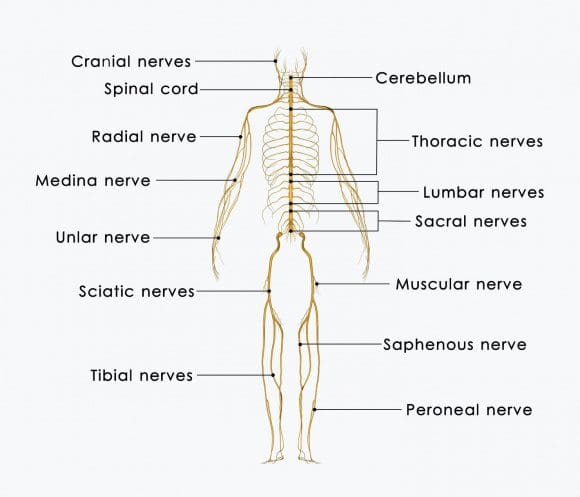
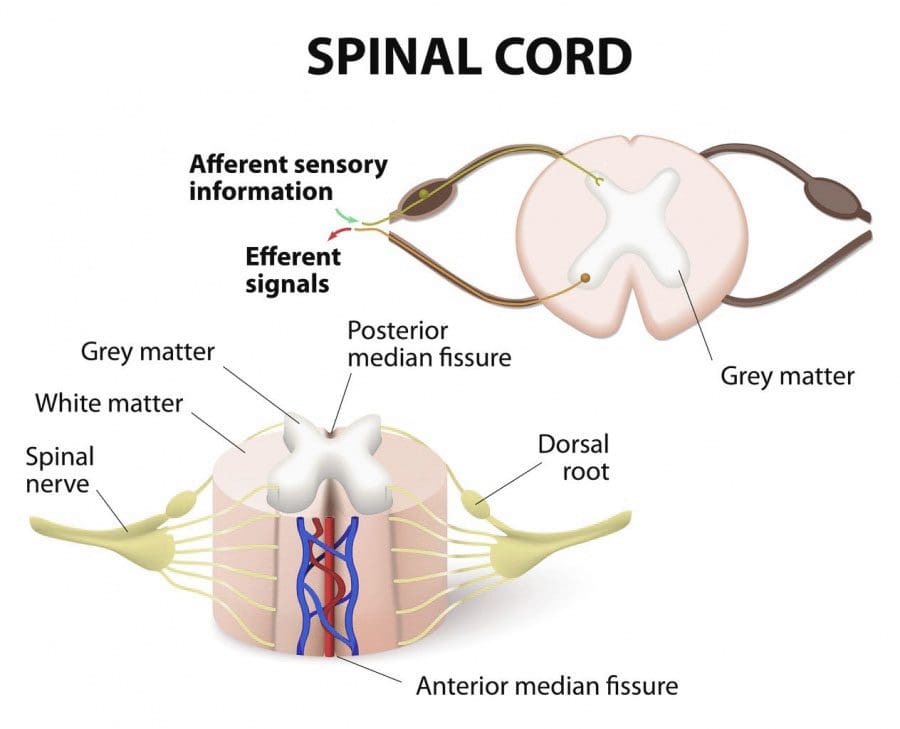
Contents
Communication
The spinal cord is about one inch across at its widest and around eighteen inches long. The spinal cord is a type of tube that is filled with nerves and cerebrospinal fluid. This protects and nourishes the cord. Spinal cord added protection includes:

There are three types of membranes surrounding the spinal cord referred to as meninges. The outer membrane is known as the dura mater, the middle membrane is the arachnoid mater and the innermost membrane is the pia mater. �
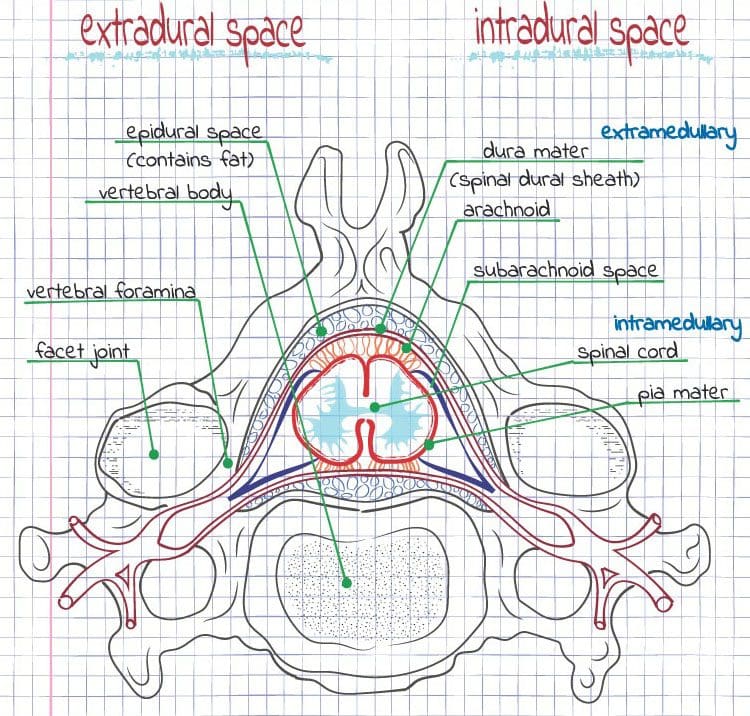
� These membranes can become inflamed and damaged by disease or trauma. Arachnoiditis is caused by inflammation of the arachnoid lining that results in intense stinging and burning pain. This can happen post-surgery and can cause the scarring of nerve/s.
The nerves exit the spinal column and branch out to the rest of the body. All parts of the body are controlled by specific spinal nerves. The nerves are placed in and around the area they control. Like the nerves in the neck area branch out into the arms. This is why a neck ache/pain issue can lead to pain spreading into the arms and hands.
- Thoracic spine controls the middle of the body,
- The lumbar spine extends into the outer legs controlling that area
- Sacral nerves control the middle of the legs and organ functions of the pelvis
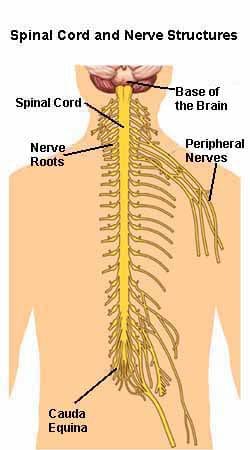
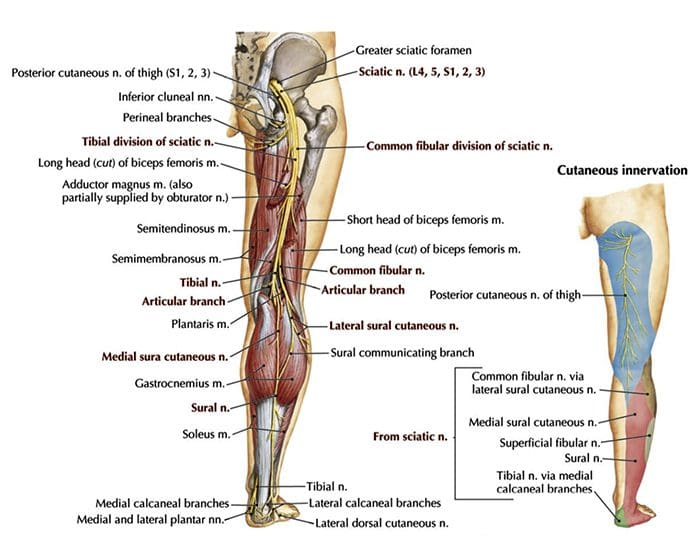
The brain
Two major types of nerves: sensory and motor. Sensory nerves send information like:
- Touch
- Temperature
- Pain
These get sent to the brain via the spinal cord. Motor nerves relay signals from the brain back to the muscles making them contract voluntarily or reflexively. Peripheral nervous system – the PNS has nerves that extend down the spinal canal and branch out at openings in the vertebrae called foramina. �
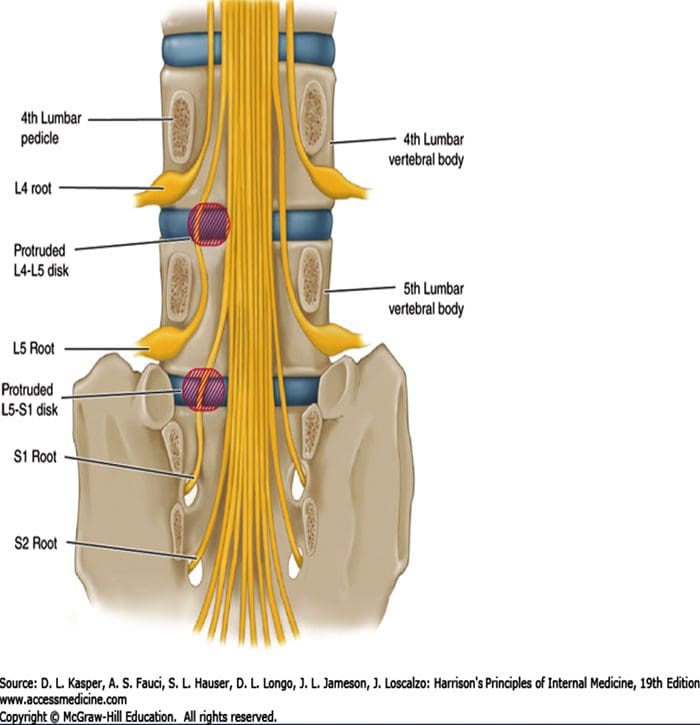
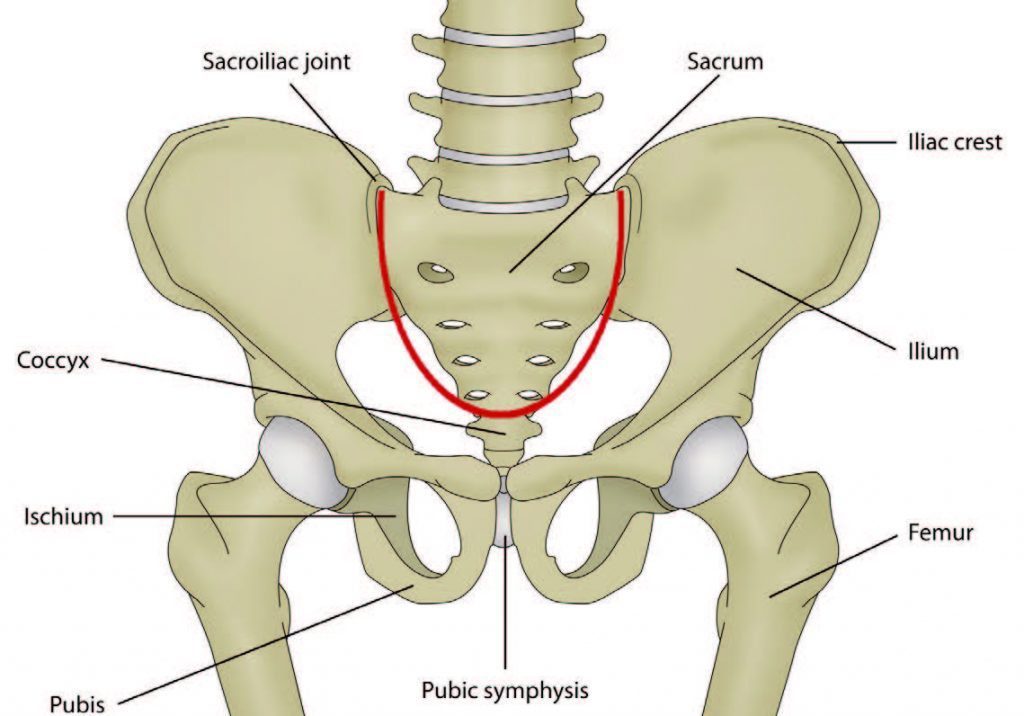
Signals/messages get sent to and from the brain aka the central nervous system. It sends all types of signals including pain and initiates movement. For example, the nerves reflexively make the spine twist and turn when driving to keep balance when turning and braking. The peripheral nervous system is a collection of millions of nerves throughout the torso and limbs. This system conveys messages to the central nervous system.
�
Referred pain
When a health problem/issue/condition takes place in one part of the body with pain being felt in another or several areas, pain specialists call it referred pain.
�
Nerves
Nerves exiting the spinal cord is done in pairs with one being a sensory nerve, and the other a motor nerve. Motor nerves initiate movement and bodily function. Damage to a motor nerve could cause a weakness in a muscle or loss of function. For example, a prick in the foot that is not felt could mean there is some sensational loss, indicating a problem with the sensory nerves and or possible nerve damage. These are the nerves that control pain, temperature, etc. Sensory nerve issues can feel like shooting electrical pain Continuing with activities could exacerbate the nerve damage.
�
Cauda Equina
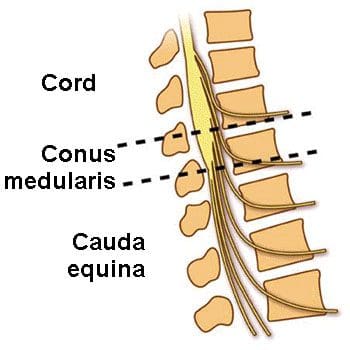
� The spinal cord ends at the lumbar low back, where the nerves extend in a bundle of strands called cauda equina, called this because it looks like a horsetail. These nerves provide motor and sensory function to the:
- Legs
- Intestines
- Genitals
- Bladder
Therefore, based on this knowledge there is adequate information displaying how sciatica could cause a delayed braking reaction time based on the nerves’ dysfunctional signal firing. Chiropractic treatment could be an option to help an individual realign their spine, work out tight muscles, nerves, ligaments preventing any further damage, and getting the individual back in top form.
�
Chiropractors & Sciatica Syndrome Expose
NCBI Resources
�
Dr. Alex Jimenez�s Blog Post Disclaimer
The scope of our information is limited to chiropractic, musculoskeletal, physical medicines, wellness, and sensitive health issues and/or functional medicine articles, topics, and discussions. We use functional health & wellness protocols to treat and support care for injuries or disorders of the musculoskeletal system. Our posts, topics, subjects, and insights cover clinical matters, issues, and topics that relate and support directly or indirectly our clinical scope of practice.*
Our office has made a reasonable attempt to provide supportive citations and has identified the relevant research study or studies supporting our posts. We also make copies of supporting research studies available to the board and or the public upon request. We understand that we cover matters that require an additional explanation as to how it may assist in a particular care plan or treatment protocol; therefore, to further discuss the subject matter above, please feel free to ask Dr. Alex Jimenez or contact us at 915-850-0900. The provider(s) Licensed in Texas& New Mexico*
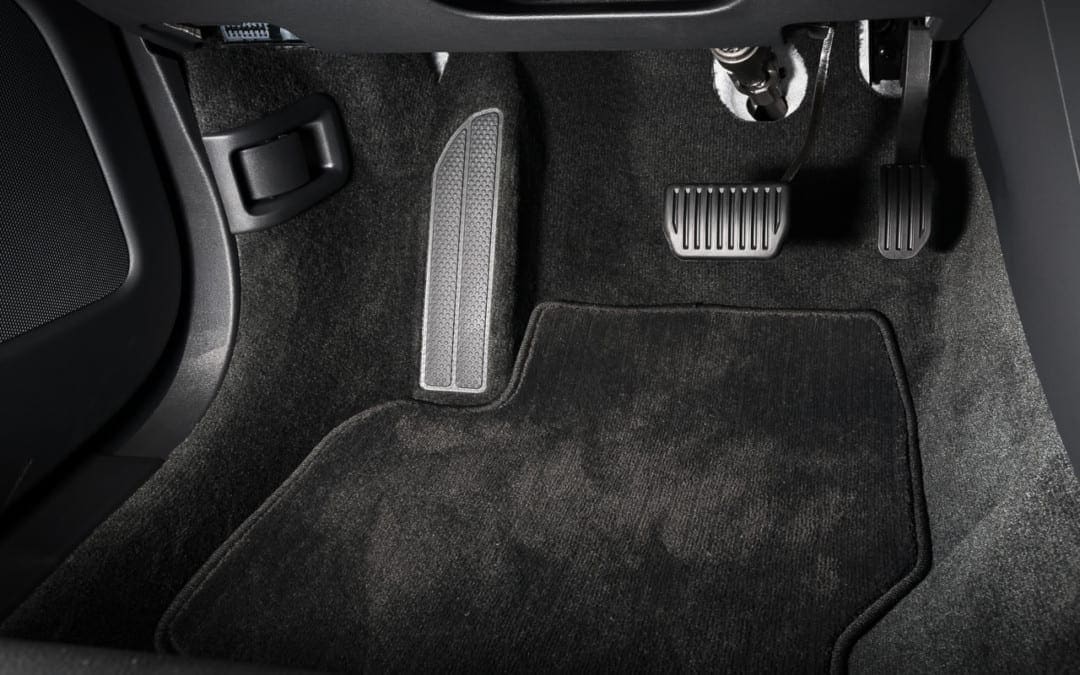
Auto Accidents Caused by Sciatica Delayed Braking Time Part 1
Research has found that individuals with disc herniation/s can have a delayed braking time when driving. After undergoing surgery these individuals showed significant improvement in braking time.
Based on this information Dr. Jimenez looks at how individuals with functional sciatica, (often caused by a herniated disc) meaning they can move and operate a vehicle to a certain point without generating pain, however they often put themselves in extreme/awkward positions just to operate, could also have a delay in brake reaction time. �
Contents
Sciatic Nerve
The sciatic nerve is a large nerve that travels from the lower back down both of the legs and into the feet.�Sciatica begins in the low back. The nerve roots in the lower spine come together and turn into the sciatic nerve. Sciatica happens when these nerves get pinched/compressed. This usually occurs from a herniated disc or when the spinal canal narrows called stenosis.
�
Symptoms
Typically, sciatica causes:
- Pain in the leg/s
- Shooting pain that goes down from the low back, through the leg, calf and sometimes into the foot
- Electrical pain running/shooting down the leg
- Burning pain
- Pain from slight movement
- Numbness
- Weakness

A car accident can cause sciatica, but now it seems that sciatica can cause an automobile accident because of delayed braking reaction time. People with sciatica that is present without pain often say there is a constant non-painful tingling, numbness, or numbing sensation along the leg that lets them know the sciatica is still there.
This could be insufficient blood flow from wherever the impingement is happening. Keep in mind that there could be multiple areas of impingement. Just like the slow blood flow, they may find when they drive the impingement slows the motor-sensory signal and braking time to depress the brake pedal fast enough to avoid a collision.
�
Nerve Treatment
Sciatica can be treated non-surgically with:
- Chiropractic
- Physical therapy
- 24 to 48 hours of rest
- Over the counter pain relievers like ibuprofen or acetaminophen
- Muscle spasms can be treated with heat or ice

� Patients with sciatica feel better with time, usually a few weeks. However, if pain continues, other forms of treatment can be discussed.�A doctor or chiropractor may advise�light exercise and therapeutic stretching. As recovery progresses they may give you exercises to strengthen the back and core.
With new automobiles implementing automatic braking systems has helped significantly reduce accidents, however, there are still bugs to sort out. This is normal with these computerized systems. Reliance upon these systems, especially those with sciatica, herniated, or bulging disc/s, could be a dangerous combination, specifically when it comes to braking reaction time.
Sciatica Pain* Treatment Relief
�
Dr. Alex Jimenez�s Blog Post Disclaimer
The scope of our information is limited to chiropractic, musculoskeletal, physical medicines, wellness, and sensitive health issues and/or functional medicine articles, topics, and discussions. We use functional health & wellness protocols to treat and support care for injuries or disorders of the musculoskeletal system. Our posts, topics, subjects, and insights cover clinical matters, issues, and topics that relate and support directly or indirectly our clinical scope of practice.*
Our office has made a reasonable attempt to provide supportive citations and has identified the relevant research study or studies supporting our posts. We make copies of supporting research studies available to the board and or the public upon request. We understand that we cover matters that require added explanation as to how it may assist in a particular care plan or treatment protocol; therefore, to further discuss the subject matter above, please feel free to ask Dr. Alex Jimenez or contact us at 915-850-0900. The provider(s) Licensed in Texas& New Mexico*

